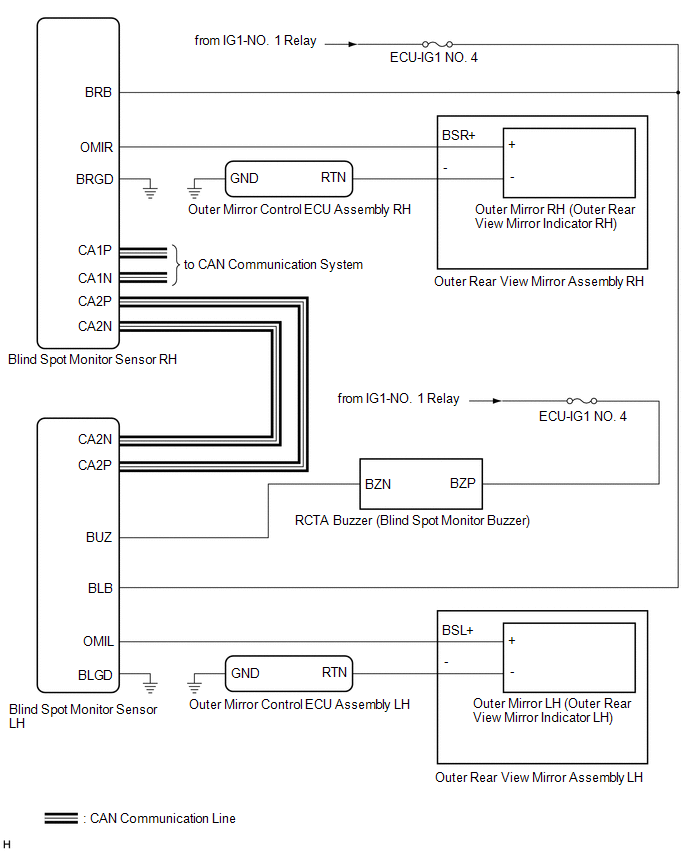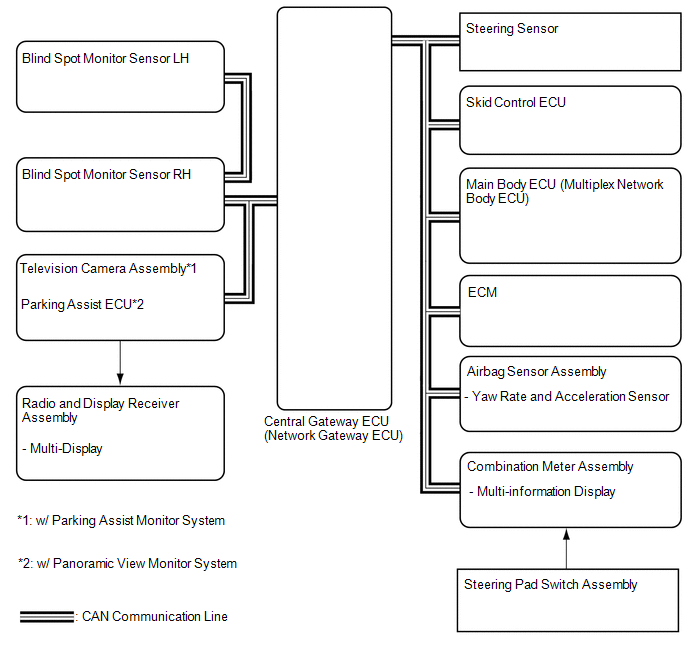Buzzer does not Sound
WIRING DIAGRAM
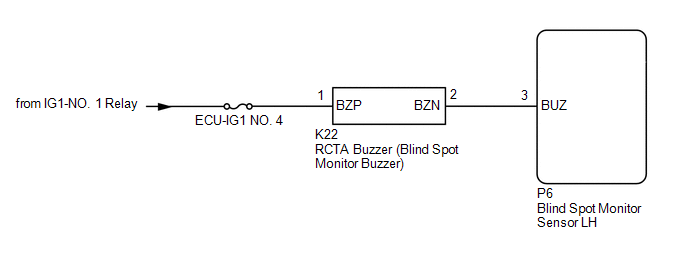
CAUTION / NOTICE / HINT
NOTICE:
- When checking for DTCs, make sure that the blind spot monitor system is turned on.
- Inspect the fuses for circuits related to this system before performing the following procedure.
PROCEDURE
|
1. | CHECK RCTA BUZZER (BLIND SPOT MONITOR BUZZER) |
(a) Check that the RCTA buzzer (blind spot monitor buzzer) sounds when the initial check is performed.
Click here 
OK:
RCTA buzzer sounds
| OK |
 | REPLACE BLIND SPOT MONITOR SENSOR LH |
|
NG |
 | |
(a) Turn the engine switch off.
(b) Turn the engine switch on (IG).
(c) Recheck for DTCs and check if the same DTC is output again.
Body Electrical > Blind Spot Monitor Slave > Trouble Codes
OK:
No DTCs are output.
| NG |  |
GO TO DTC CHART |
|
OK |
 | |
| 3. |
CHECK HARNESS AND CONNECTOR (RCTA BUZZER - BLIND SPOT MONITOR SENSOR LH) |
(a) Disconnect the K22 RCTA buzzer (blind spot monitor buzzer) connector.
(b) Measure the voltage according to the value(s) in the table below.
Standard Voltage:
|
Tester Connection | Switch Condition |
Specified Condition |
|
K22-1 (BZP) - Body ground |
Engine Switch on (IG) |
11 to 14 V |
|
K22-2 (BZN) or P6-3 (BUZ) - Body ground |
Below 1 V |
|
K22-2 (BZN) - K22-1 (BZP) |
Below 1 V |
| NG |
 | REPAIR OR REPLACE HARNESS OR CONNECTOR |
|
OK |
 | |
| 4. |
CHECK HARNESS AND CONNECTOR (RCTA BUZZER - BLIND SPOT MONITOR SENSOR LH AND BATTERY) |
(a) Disconnect the K22 RCTA buzzer (blind spot monitor buzzer) connector.
(b) Disconnect the P6 blind spot monitor sensor LH connector.
(c) Measure the resistance according to the value(s) in the table below.
Standard Resistance:
|
Tester Connection | Condition |
Specified Condition |
|
K22-2 (BZN) - P6-3 (BUZ) |
Always | Below 1 Ω |
|
K22-2 (BZN) or P6-3 (BUZ) - Body ground |
Always | 10 kΩ or higher |
(d) Measure the voltage according to the value(s) in the table below.
Standard Voltage:
|
Tester Connection | Switch Condition |
Specified Condition |
|
K22-2 (BZN) or P6-3 (BUZ) - Body ground |
Engine switch on (IG) |
Below 1 V |
|
K22-1 (BZP) - Body ground |
Engine switch on (IG) |
11 to 14 V |
|
K22-1 (BZP) - Body ground |
Engine switch off | Below 1 V |
| OK |
 | REPLACE RCTA BUZZER (BLIND SPOT MONITOR BUZZER) |
| NG |
 | REPAIR OR REPLACE HARNESS OR CONNECTOR |
Vehicle Speed Sensor (C1A45)
DESCRIPTION
The blind spot monitor sensor receives vehicle speed signals from the skid control ECU via CAN communication.
Blind Spot Monitor Master |
DTC No. | Detection Item |
DTC Detection Condition | Trouble Area |
|
C1A45 | Vehicle Speed Sensor |
A fail flag is transmitted from the skid control ECU |
- Electronically controlled brake system
- Blind spot monitor sensor RH
|
Blind Spot Monitor Slave |
DTC No. | Detection Item |
DTC Detection Condition | Trouble Area |
|
C1A45 | Vehicle Speed Sensor |
A fail flag is transmitted from the skid control ECU |
- Electronically controlled brake system
- Blind spot monitor sensor LH
|
CAUTION / NOTICE / HINT
NOTICE:
When checking for DTCs, make sure that the blind spot monitor system is turned on.
PROCEDURE
| 1. |
CHECK OTHER DTC OUTPUT (ELECTRONICALLY CONTROLLED BRAKE SYSTEM) |
(a) Turn the engine switch off.
(b) Connect the Techstream to the DLC3.
(c) Turn the engine switch on (IG).
(d) Turn the Techstream on.
(e) Read the DTCs following the prompts on the Techstream. Enter the following menus: Chassis / ABS/VSC/TRAC / Trouble Codes.
Chassis > ABS/VSC/TRAC > Trouble Codes
OK:
Electronically controlled brake system DTCs are not output.
| NG |
 | GO TO ELECTRONICALLY CONTROLLED BRAKE SYSTEM |
|
OK |
 | |
(a) Turn the engine switch off.
(b) Turn the engine switch on (IG).
(c) Recheck for DTCs and check if the same DTC is output again.
Body Electrical > Blind Spot Monitor Master > Trouble Codes Body
Electrical > Blind Spot Monitor Slave > Trouble Codes
|
Result | Proceed to |
|
No DTCs are output | A |
|
DTC C1A45 is output ("Blind Spot Monitor Master") |
B |
| DTC C1A45 is output ("Blind Spot Monitor Slave") |
C |
| A |
 | USE SIMULATION METHOD TO CHECK |
| B |
 | REPLACE BLIND SPOT MONITOR SENSOR RH |
| C |
 | REPLACE BLIND SPOT MONITOR SENSOR LH |
Yaw Rate Sensor (C1A46)
DESCRIPTION
The blind spot
monitor sensor receives yaw rate signals from the airbag sensor assembly
(yaw rate and acceleration sensor) via CAN communication.
Blind Spot Monitor Master |
DTC No. | Detection Item |
DTC Detection Condition | Trouble Area |
|
C1A46 | Yaw Rate Sensor |
A fail flag is transmitted from the airbag sensor assembly |
- Electronically controlled brake system
- Blind spot monitor sensor RH
|
Blind Spot Monitor Slave |
DTC No. | Detection Item |
DTC Detection Condition | Trouble Area |
|
C1A46 | Yaw Rate Sensor |
A fail flag is transmitted from the airbag sensor assembly |
- Electronically controlled brake system
- Blind spot monitor sensor LH
|
CAUTION / NOTICE / HINT
NOTICE:
When checking for DTCs, make sure that the blind spot monitor system is turned on.
PROCEDURE
| 1. |
CHECK OTHER DTC OUTPUT (ELECTRONICALLY CONTROLLED BRAKE SYSTEM) |
(a) Turn the engine switch off.
(b) Connect the Techstream to the DLC3.
(c) Turn the engine switch on (IG).
(d) Turn the Techstream on.
(e) Read the DTCs following the prompts on the Techstream. Enter the following menus: Chassis / ABS/VSC/TRAC / Trouble Codes.
Chassis > ABS/VSC/TRAC > Trouble Codes
OK:
Electronically controlled brake system DTCs are not output.
| NG |
 | GO TO ELECTRONICALLY CONTROLLED BRAKE SYSTEM |
|
OK |
 | |
(a) Turn the engine switch off.
(b) Turn the engine switch on (IG).
(c) Recheck for DTCs and check if the same DTC is output again.
Body Electrical > Blind Spot Monitor Master > Trouble Codes Body
Electrical > Blind Spot Monitor Slave > Trouble Codes
|
Result | Proceed to |
|
No DTCs are output. | A |
|
DTC C1A46 is output ("Blind Spot Monitor Master"). |
B |
| DTC C1A46 is output ("Blind Spot Monitor Slave"). |
C |
| A |
 | USE SIMULATION METHOD TO CHECK |
| B |
 | REPLACE BLIND SPOT MONITOR SENSOR RH |
| C |
 | REPLACE BLIND SPOT MONITOR SENSOR LH |
Steering Angle Sensor (C1A47)
DESCRIPTION
The blind spot monitor sensor receives steering angle signals from the steering sensor via CAN communication.
Blind Spot Monitor Master |
DTC No. | Detection Item |
DTC Detection Condition | Trouble Area |
|
C1A47 | Steering Angle Sensor |
A fail flag is transmitted from the steering angle sensor |
- Steering sensor
- Blind spot monitor sensor RH
|
Blind Spot Monitor Slave |
DTC No. | Detection Item |
DTC Detection Condition | Trouble Area |
|
C1A47 | Steering Angle Sensor |
A fail flag is transmitted from the steering angle sensor |
- Steering sensor
- Blind spot monitor sensor LH
|
CAUTION / NOTICE / HINT
NOTICE:
When checking for DTCs, make sure that the blind spot monitor system is turned on.
PROCEDURE
(a) Turn the engine switch off.
(b) Turn the engine switch on (IG).
(c) Recheck for DTCs and check if the same DTC is output again.
Body Electrical > Blind Spot Monitor Master > Trouble Codes Body
Electrical > Blind Spot Monitor Slave > Trouble Codes OK:
No DTCs are output.
| OK |
 | USE SIMULATION METHOD TO CHECK |
|
NG |
 | |
| 2. |
REPLACE STEERING SENSOR |
(a) Replace the steering sensor with a new or known good one.
Click here 
|
NEXT |
 | |
(a) Turn the engine switch off.
(b) Turn the engine switch on (IG).
(c) Recheck for DTCs and check if the same DTC is output again.
Body Electrical > Blind Spot Monitor Master > Trouble Codes Body
Electrical > Blind Spot Monitor Slave > Trouble Codes
|
Result | Proceed to |
|
No DTCs are output | A |
|
DTC C1A47 is output ("Blind Spot Monitor Master") |
B |
| DTC C1A47 is output ("Blind Spot Monitor Slave") |
C |
| A |
 | END |
| B |
 | REPLACE BLIND SPOT MONITOR SENSOR RH |
| C |
 | REPLACE BLIND SPOT MONITOR SENSOR LH |
Short to +B in Outer Mirror Indicator(Master) (C1AB0)
DESCRIPTION
This DTC is stored when the blind spot monitor sensor RH detects a short to +B in the outer rear view mirror indicator RH.
|
DTC No. | Detection Item |
DTC Detection Condition | Trouble Area |
|
C1AB0 | Short to +B in Outer Mirror Indicator(Master) | Both of the following conditions are met:
- The blind spot monitor system is on
- The blind spot monitor sensor is not sending voltage to the indicator
but the indicator receives voltage above a specified level for a
specified period of time
|
- Outer mirror RH
- Outer rear view mirror assembly RH
- Wire harness or connector
- Blind spot monitor sensor RH
|
WIRING DIAGRAM
w/o Seat Memory
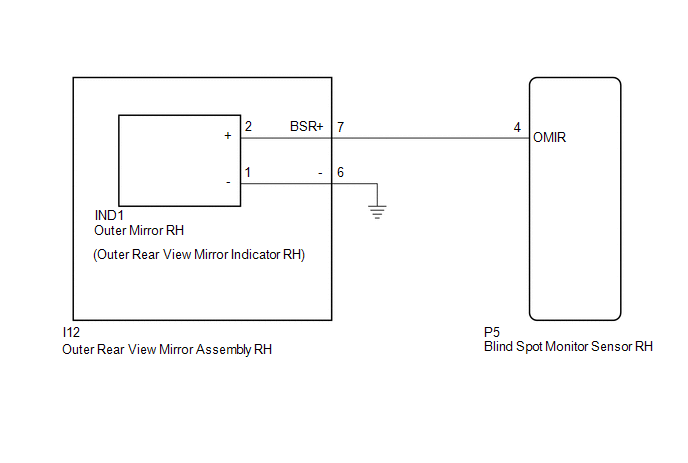 w/ Seat Memory.
w/ Seat Memory.
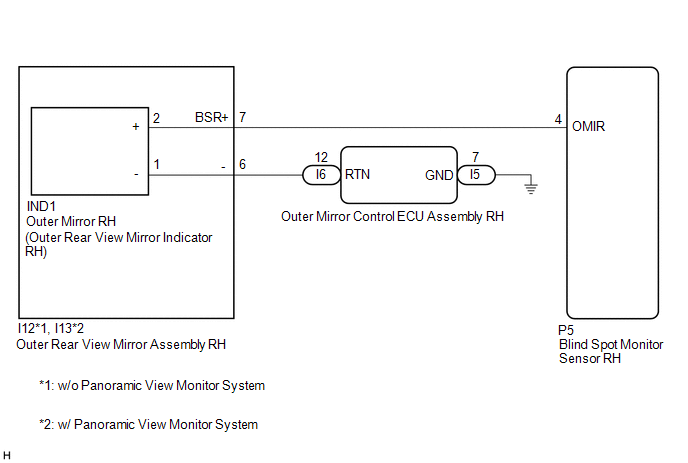
CAUTION / NOTICE / HINT
NOTICE:
When checking for DTCs, make sure that the blind spot monitor system is turned on.
PROCEDURE
(a) Turn the engine switch off.
(b) Turn the engine switch on (IG).
(c) Recheck for DTCs and check if the same DTC is output again.
Body Electrical > Blind Spot Monitor Master > Trouble Codes
OK:
No DTCs are output.
| OK |  |
USE SIMULATION METHOD TO CHECK |
|
NG |
 | |
| 2. |
CHECK HARNESS AND CONNECTOR (OUTER REAR VIEW MIRROR INDICATOR CIRCUIT) |
(a) Disconnect the P5 blind spot monitor sensor RH connector.
(b) Measure the voltage according to the value(s) in the table below.
Standard Voltage:
|
Tester Connection | Condition |
Specified Condition |
|
P5-4 (OMIR) - Body ground |
Engine switch on (IG) |
Below 1 V |
| OK |
 | REPLACE BLIND SPOT MONITOR SENSOR RH |
|
NG |
 | |
| 3. |
CHECK HARNESS AND CONNECTOR (OUTER REAR VIEW MIRROR INDICATOR CIRCUIT) |
(a) Disconnect the IND1 outer mirror RH connector.
(b) Measure the voltage according to the value(s) in the table below.
Standard Voltage:
|
Tester Connection | Condition |
Specified Condition |
|
P5-4 (OMIR) - Body ground |
Engine switch on (IG) |
Below 1 V |
| OK |
 | REPLACE OUTER MIRROR RH |
|
NG |
 | |
| 4. |
CHECK HARNESS AND CONNECTOR (OUTER REAR VIEW MIRROR INDICATOR CIRCUIT) |
(a) Disconnect the I12*1 or I13*2 outer rear view mirror assembly RH connector.
(b) Measure the voltage according to the value(s) in the table below.
Standard Voltage:
|
Tester Connection | Condition |
Specified Condition |
|
P5-4 (OMIR) - Body ground |
Engine switch on (IG) |
Below 1 V |
- *1: w/o Panoramic View Monitor System
- *2: w/ Panoramic View Monitor System
| OK |
 | REPLACE OUTER REAR VIEW MIRROR ASSEMBLY RH |
| NG |
 | REPAIR OR REPLACE HARNESS OR CONNECTOR |
Short to +B in Outer Mirror Indicator(Slave) (C1AB1)
DESCRIPTION
This DTC is stored when the blind spot monitor sensor LH detects a short to +B in the outer rear view mirror indicator LH.
|
DTC No. | Detection Item |
DTC Detection Condition | Trouble Area |
|
C1AB1 | Short to +B in Outer Mirror Indicator(Slave) | Both of the following conditions are met:
- The blind spot monitor system is on
- The blind spot monitor sensor is not sending voltage to the indicator
but the indicator receives voltage above a specified level for a
specified period of time
|
- Outer mirror LH
- Outer rear view mirror assembly LH
- Wire harness or connector
- Blind spot monitor sensor LH
|
WIRING DIAGRAM
w/o Seat Memory
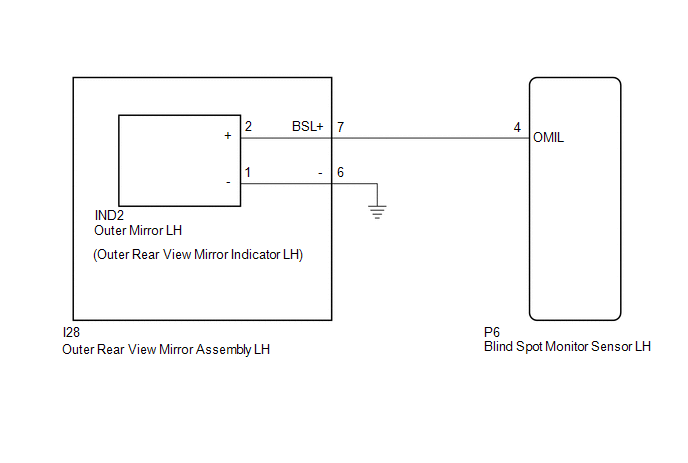 w/ Seat Memory
w/ Seat Memory
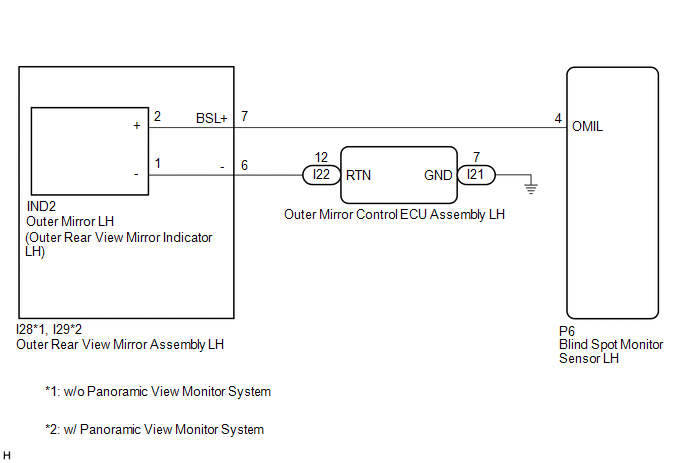
CAUTION / NOTICE / HINT
NOTICE:
When checking for DTCs, make sure that the blind spot monitor system is turned on.
PROCEDURE
(a) Turn the engine switch off.
(b) Turn the engine switch on (IG).
(c) Recheck for DTCs and check if the same DTC is output again.
Body Electrical > Blind Spot Monitor Slave > Trouble Codes
OK:
No DTCs are output.
| OK |  |
USE SIMULATION METHOD TO CHECK |
|
NG |
 | |
| 2. |
CHECK HARNESS AND CONNECTOR (OUTER REAR VIEW MIRROR INDICATOR CIRCUIT) |
(a) Disconnect the P6 blind spot monitor sensor LH connector.
(b) Measure the voltage according to the value(s) in the table below.
Standard Voltage:
|
Tester Connection | Condition |
Specified Condition |
|
P6-4 (OMIL) - Body ground |
Engine Switch on (IG) |
Below 1 V |
| OK |
 | REPLACE BLIND SPOT MONITOR SENSOR LH |
|
NG |
 | |
| 3. |
CHECK HARNESS AND CONNECTOR (OUTER REAR VIEW MIRROR INDICATOR CIRCUIT) |
(a) Disconnect the IND2 outer mirror LH connector.
(b) Measure the voltage according to the value(s) in the table below.
Standard Voltage:
|
Tester Connection | Condition |
Specified Condition |
|
P6-4 (OMIL) - Body ground |
Engine Switch on (IG) |
Below 1 V |
| OK |
 | REPLACE OUTER MIRROR LH |
|
NG |
 | |
| 4. |
CHECK HARNESS AND CONNECTOR (OUTER REAR VIEW MIRROR INDICATOR CIRCUIT) |
(a) Disconnect the I28*1 or I29*2 outer rear view mirror assembly LH connector.
(b) Measure the voltage according to the value(s) in the table below.
Standard Voltage:
|
Tester Connection | Condition |
Specified Condition |
|
P6-4 (OMIL) - Body ground |
Engine Switch on (IG) |
Below 1 V |
- *1: w/o Panoramic View Monitor System
- *2: w/ Panoramic View Monitor System
| OK |
 | REPLACE OUTER REAR VIEW MIRROR ASSEMBLY LH |
| NG |
 | REPAIR OR REPLACE HARNESS OR CONNECTOR |
Short to GND in Outer Mirror Indicator(Master) (C1AB2)
DESCRIPTION
This DTC is stored when the blind spot monitor sensor RH detects a short to ground in the outer rear view mirror indicator RH.
|
DTC No. | Detection Item |
DTC Detection Condition | Trouble Area |
|
C1AB2 | Short to GND in Outer Mirror Indicator(Master) | Both of the following conditions are met:
- The blind spot monitor system is on
- The current that is sent from the blind spot monitor sensor to the
indicator is above a specified level for a specified period of time
|
- Outer mirror RH
- Outer rear view mirror assembly RH
- Wire harness or connector
- Blind spot monitor sensor RH
|
WIRING DIAGRAM
w/o Seat Memory
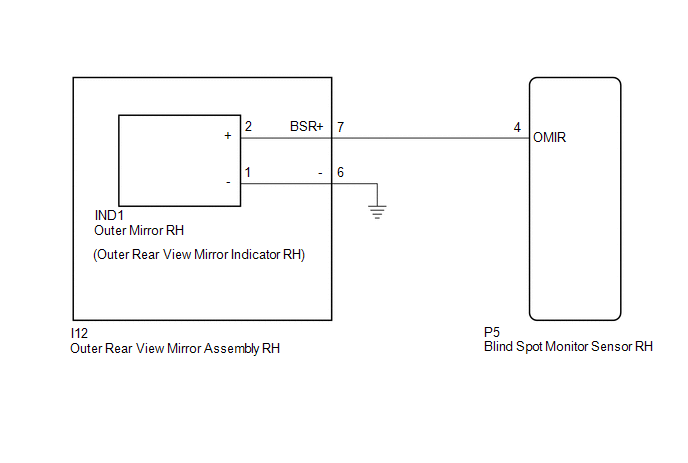 w/ Seat Memory
w/ Seat Memory
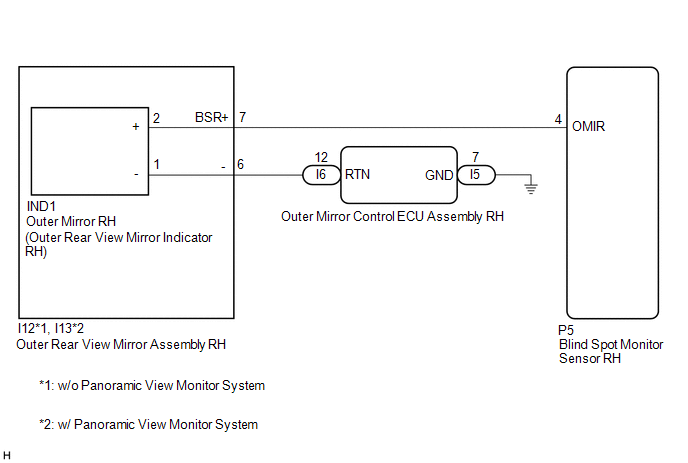
CAUTION / NOTICE / HINT
NOTICE:
When checking for DTCs, make sure that the blind spot monitor system is turned on.
PROCEDURE
(a) Turn the engine switch off.
(b) Turn the engine switch on (IG).
(c) Recheck for DTCs and check if the same DTC is output again.
Body Electrical > Blind Spot Monitor Master > Trouble Codes
OK:
No DTCs are output.
| OK |  |
USE SIMULATION METHOD TO CHECK |
|
NG |
 | |
| 2. |
CHECK HARNESS AND CONNECTOR (BLIND SPOT MONITOR SENSOR RH - OUTER REAR VIEW MIRROR ASSEMBLY RH) |
(a) Disconnect the P5 blind spot monitor sensor RH connector.
(b) Disconnect the I12*1 or I13*2 outer rear view mirror assembly RH connector.
(c) Measure the resistance according to the value(s) in the table below.
Standard Resistance:
|
Tester Connection | Condition |
Specified Condition |
|
P5-4 (OMIR) or I12-7 (BSR+) - Body ground*1 |
Always | 10 kΩ or higher |
|
P5-4 (OMIR) or I13-7 (BSR+) - Body ground*2 |
Always | 10 kΩ or higher |
- *1: w/o Panoramic View Monitor System
- *2: w/ Panoramic View Monitor System
| NG |
 | REPAIR OR REPLACE HARNESS OR CONNECTOR |
|
OK |
 | |
| 3. |
INSPECT OUTER REAR VIEW MIRROR ASSEMBLY RH |
(a) Disconnect the IND1 outer mirror RH connector.
(b) Measure the resistance according to the value(s) in the table below.
Standard Resistance:
|
Tester Connection | Condition |
Specified Condition |
|
I12-7 (BSR+) or IND1-2 (+) - Body ground*1 |
Always | 10 kΩ or higher |
|
I13-7 (BSR+) or IND1-2 (+) - Body ground*2 |
Always | 10 kΩ or higher |
- *1: w/o Panoramic View Monitor System
- *2: w/ Panoramic View Monitor System
| NG |
 | REPLACE OUTER REAR VIEW MIRROR ASSEMBLY RH |
|
OK |
 | |
| 4. |
INSPECT OUTER MIRROR RH |
(a) Remove the outer mirror RH.
Click here 
(b) Inspect the outer rear view mirror indicator RH on the outer mirror RH.
Click here 
| OK |
 | REPLACE BLIND SPOT MONITOR SENSOR RH |
| NG |
 | REPLACE OUTER MIRROR RH |
Short to GND in Outer Mirror Indicator(Slave) (C1AB3)
DESCRIPTION
This DTC is stored when the blind spot monitor sensor LH detects a short to ground in the outer rear view mirror indicator LH.
|
DTC No. | Detection Item |
DTC Detection Condition | Trouble Area |
|
C1AB3 | Short to GND in Outer Mirror Indicator(Slave) | Both of the following conditions are met:
- The blind spot monitor system is on
- The current that is sent from the blind spot monitor sensor to the
indicator is above a specified level for a specified period of time
|
- Outer mirror LH
- Outer rear view mirror assembly LH
- Wire harness or connector
- Blind spot monitor sensor LH
|
WIRING DIAGRAM
w/o Seat Memory
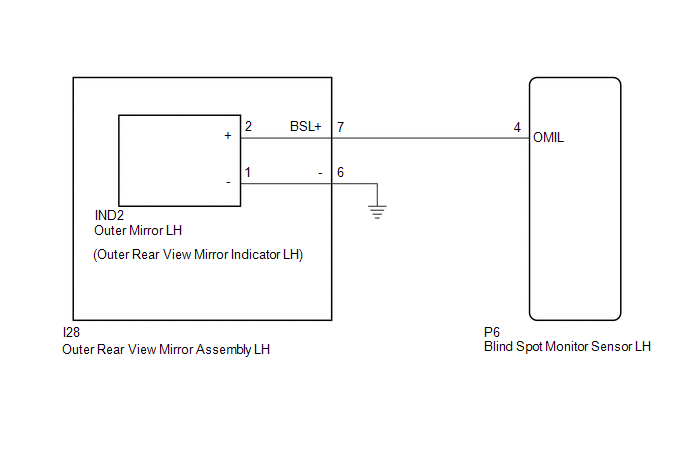 w/ Seat Memory
w/ Seat Memory
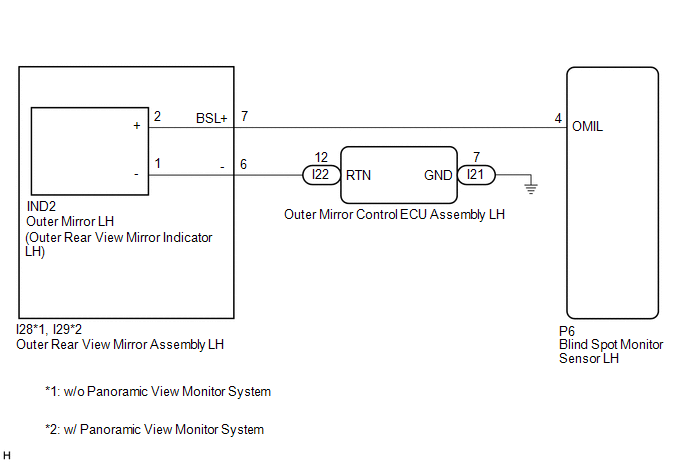
CAUTION / NOTICE / HINT
NOTICE:
When checking for DTCs, make sure that the blind spot monitor system is turned on.
PROCEDURE
(a) Turn the engine switch off.
(b) Turn the engine switch on (IG).
(c) Recheck for DTCs and check if the same DTC is output again.
Body Electrical > Blind Spot Monitor Slave > Trouble Codes
OK:
No DTCs are output.
| OK |  |
USE SIMULATION METHOD TO CHECK |
|
NG |
 | |
| 2. |
CHECK HARNESS AND CONNECTOR (BLIND SPOT MONITOR SENSOR LH - OUTER REAR VIEW MIRROR ASSEMBLY LH) |
(a) Disconnect the P6 blind spot monitor sensor LH connector.
(b) Disconnect the I28*1 or I29*2 outer rear view mirror assembly LH connector.
(c) Measure the resistance according to the value(s) in the table below.
Standard Resistance:
|
Tester Connection | Condition |
Specified Condition |
|
P6-4 (OMIL) or I28-7 (BSL+) - Body ground*1 |
Always | 10 kΩ or higher |
|
P6-4 (OMIL) or I29-7 (BSL+) - Body ground*2 |
Always | 10 kΩ or higher |
- *1: w/o Panoramic View Monitor System
- *2: w/ Panoramic View Monitor System
| NG |
 | REPAIR OR REPLACE HARNESS OR CONNECTOR |
|
OK |
 | |
| 3. |
INSPECT OUTER REAR VIEW MIRROR ASSEMBLY LH |
(a) Disconnect the IND2 outer mirror LH connector.
(b) Measure the resistance according to the value(s) in the table below.
Standard Resistance:
|
Tester Connection | Condition |
Specified Condition |
|
I28-7 (BSL+) or IND2-2 (+) - Body ground*1 |
Always | 10 kΩ or higher |
|
I29-7 (BSL+) or IND2-2 (+) - Body ground*2 |
Always | 10 kΩ or higher |
- *1: w/o Panoramic View Monitor System
- *2: w/ Panoramic View Monitor System
| NG |
 | REPLACE OUTER REAR VIEW MIRROR ASSEMBLY LH |
|
OK |
 | |
| 4. |
INSPECT OUTER MIRROR LH |
(a) Remove the outer mirror LH.
Click here 
(b) Inspect the outer rear view mirror indicator LH on the outer mirror LH.
Click here 
| OK |
 | REPLACE BLIND SPOT MONITOR SENSOR LH |
| NG |
 | REPLACE OUTER MIRROR LH |
Open in Outer Mirror Indicator(Master) (C1AB4)
DESCRIPTION
This DTC is stored when the blind spot monitor sensor RH detects an open in the outer rear view mirror indicator RH.
|
DTC No. | Detection Item |
DTC Detection Condition | Trouble Area |
|
C1AB4 | Open in Outer Mirror Indicator(Master) | Both of the following conditions are met:
- The blind spot monitor system is on
- The current flowing to the indicator is below a specified value when indicator operation voltage is being sent to the indicator
|
- Outer mirror RH
- Outer rear view mirror assembly RH
- Wire harness or connector
- Blind spot monitor sensor RH
- Outer mirror control ECU assembly RH*
|
WIRING DIAGRAM
w/o Seat Memory
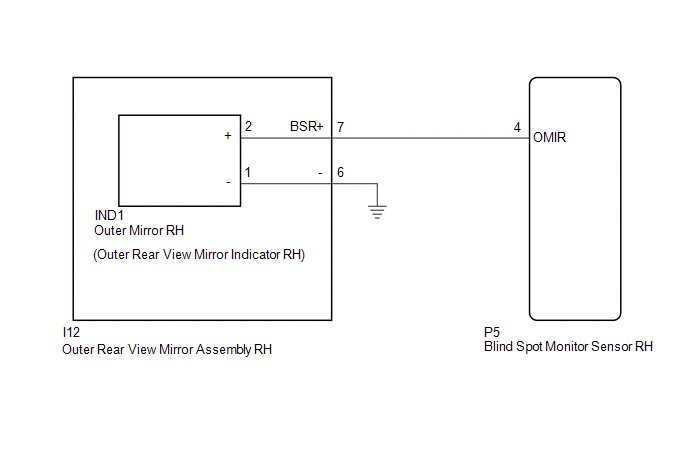 w/ Seat Memory
w/ Seat Memory
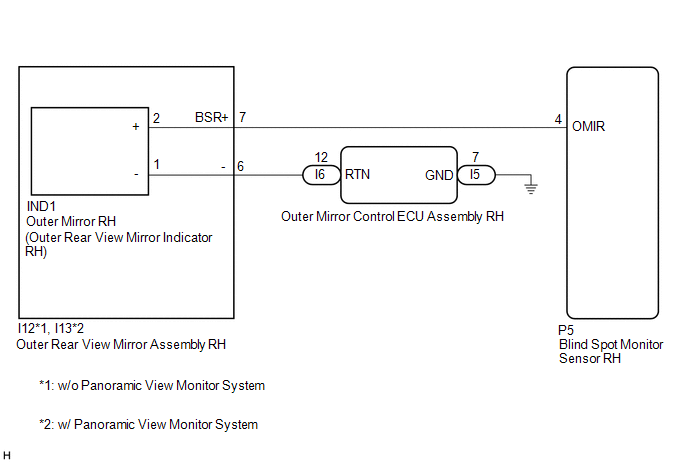
CAUTION / NOTICE / HINT
NOTICE:
When checking for DTCs, make sure that the blind spot monitor system is turned on.
PROCEDURE
(a) Turn the engine switch off.
(b) Turn the engine switch on (IG).
(c) Recheck for DTCs and check if the same DTC is output again.
Body Electrical > Blind Spot Monitor Master > Trouble Codes
OK:
No DTCs are output.
|
Result | Proceed to |
|
OK | A |
|
NG (w/o Seat Memory) |
B |
| NG (w/ Seat Memory) |
C |
| A |
 | USE SIMULATION METHOD TO CHECK |
| C |
 | GO TO STEP 5 |
|
B |
 | |
| 2. |
CHECK HARNESS AND CONNECTOR (OUTER REAR VIEW MIRROR ASSEMBLY RH - BLIND SPOT MONITOR SENSOR RH AND BODY GROUND) |
(a) Disconnect the P5 blind spot monitor sensor RH connector.
(b) Disconnect the I12 outer rear view mirror assembly RH connector.
(c) Measure the resistance according to the value(s) in the table below.
Standard Resistance:
|
Tester Connection | Condition |
Specified Condition |
|
P5-4 (OMIR) - I12-7 (BSR+) |
Always | Below 1 Ω |
|
I12-6 (-) - Body ground |
Always | Below 1 Ω |
| NG |
 | REPAIR OR REPLACE HARNESS OR CONNECTOR |
|
OK |
 | |
| 3. |
INSPECT OUTER REAR VIEW MIRROR ASSEMBLY RH |
(a) Disconnect the IND1 outer mirror RH connector.
(b) Measure the resistance according to the value(s) in the table below.
Standard Resistance:
|
Tester Connection | Condition |
Specified Condition |
|
I12-7 (BSR+) - IND1-2 (+) |
Always | Below 1 Ω |
|
I12-6 (-) - IND1-1 (-) |
Always | Below 1 Ω |
| NG |
 | REPLACE OUTER REAR VIEW MIRROR ASSEMBLY RH |
|
OK |
 | |
| 4. |
INSPECT OUTER MIRROR RH |
(a) Remove the outer mirror RH.
Click here 
(b) Inspect the outer rear view mirror indicator RH on the outer mirror RH.
Click here 
| OK |
 | REPLACE BLIND SPOT MONITOR SENSOR RH |
| NG |
 | REPLACE OUTER MIRROR RH |
| 5. |
CHECK HARNESS AND CONNECTOR (OUTER REAR VIEW MIRROR ASSEMBLY RH - BLIND SPOT MONITOR SENSOR RH) |
(a) Disconnect the P5 blind spot monitor sensor RH connector.
(b) Disconnect the I12*1 or I13*2 outer rear view mirror assembly RH connector.
(c) Measure the resistance according to the value(s) in the table below.
Standard Resistance:
|
Tester Connection | Condition |
Specified Condition |
|
P5-4 (OMIR) - I12-7 (BSR+)*1 |
Always | Below 1 Ω |
|
P5-4 (OMIR) - I13-7 (BSR+)*2 |
Always | Below 1 Ω |
- *1: w/o Panoramic View Monitor System
- *2: w/ Panoramic View Monitor System
| NG |
 | REPAIR OR REPLACE HARNESS OR CONNECTOR |
|
OK |
 | |
| 6. |
CHECK HARNESS AND CONNECTOR (OUTER REAR VIEW MIRROR ASSEMBLY RH - OUTER MIRROR CONTROL ECU ASSEMBLY RH AND BODY GROUND) |
(a) Disconnect the I12*1 or I13*2 outer rear view mirror assembly RH connector.
(b) Disconnect the I5 and I6 outer mirror control ECU assembly RH connectors.
(c) Measure the resistance according to the value(s) in the table below.
Standard Resistance:
|
Tester Connection | Condition |
Specified Condition |
|
I12-6 (-) - I6-12 (RTN)*1 |
Always | Below 1 Ω |
|
I13-6 (-) - I6-12 (RTN)*2 |
Always | Below 1 Ω |
|
I5-7 (GND) - Body ground |
Always | Below 1 Ω |
- *1: w/o Panoramic View Monitor System
- *2: w/ Panoramic View Monitor System
| NG |
 | REPAIR OR REPLACE HARNESS OR CONNECTOR |
|
OK |
 | |
| 7. |
INSPECT OUTER MIRROR CONTROL ECU ASSEMBLY RH |
(a) Disconnect the I5 and I6 outer mirror control ECU assembly RH connectors.
| (b) Measure the resistance according to the value(s) in the table below.
Standard Resistance: |
Tester Connection | Condition |
Specified Condition | |
I5-7 (GND) - I6-12 (RTN) |
Always | Below 1 Ω | |
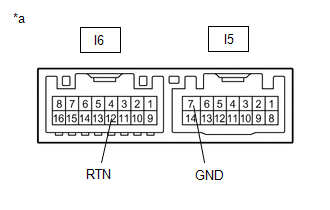 |
|
*a | Component without harness connected
(Outer Mirror Control ECU Assembly RH) | | |
| NG |
 | REPLACE OUTER MIRROR CONTROL ECU ASSEMBLY RH |
|
OK |
 | |
| 8. |
INSPECT OUTER REAR VIEW MIRROR ASSEMBLY RH |
(a) Disconnect the IND1 outer mirror RH connector.
(b) Measure the resistance according to the value(s) in the table below.
Standard Resistance:
|
Tester Connection | Condition |
Specified Condition |
|
I12-7 (BSR+) - IND1-2 (+)*1 |
Always | Below 1 Ω |
|
I12-6 (-) - IND1-1 (-)*1 |
Always | Below 1 Ω |
|
I13-7 (BSR+) - IND1-2 (+)*2 |
Always | Below 1 Ω |
|
I13-6 (-) - IND1-1 (-)*2 |
Always | Below 1 Ω |
- *1: w/o Panoramic View Monitor System
- *2: w/ Panoramic View Monitor System
| NG |
 | REPLACE OUTER REAR VIEW MIRROR ASSEMBLY RH |
|
OK |
 | |
| 9. |
INSPECT OUTER MIRROR RH |
(a) Remove the outer mirror RH.
Click here 
(b) Inspect the outer rear view mirror indicator RH on the outer mirror RH.
Click here 
| OK |
 | REPLACE BLIND SPOT MONITOR SENSOR RH |
| NG |
 | REPLACE OUTER MIRROR RH |
Open in Outer Mirror Indicator(Slave) (C1AB5)
DESCRIPTION
This DTC is stored when the blind spot monitor sensor LH detects an open in the outer rear view mirror indicator LH.
|
DTC No. | Detection Item |
DTC Detection Condition | Trouble Area |
|
C1AB5 | Open in Outer Mirror Indicator(Slave) | Both of the following conditions are met:
- The blind spot monitor system is on
- The current flowing to the indicator is below a specified value when indicator operation voltage is being sent to the indicator
|
- Outer mirror LH
- Outer rear view mirror assembly LH
- Wire harness or connector
- Blind spot monitor sensor LH
- Outer mirror control ECU assembly LH*
|
WIRING DIAGRAM
w/o Seat Memory
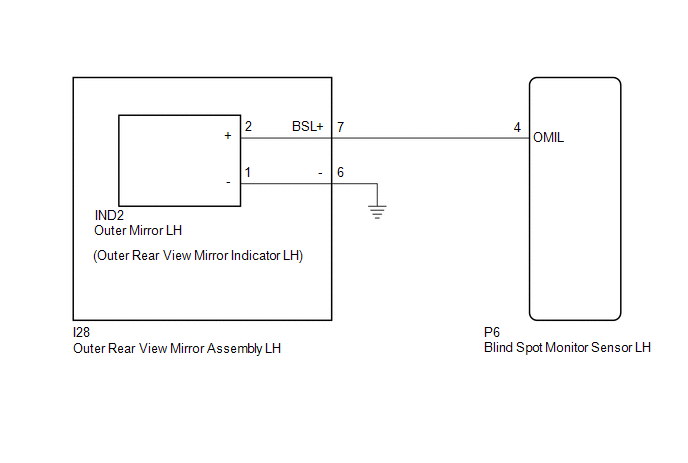 w/ Seat Memory
w/ Seat Memory
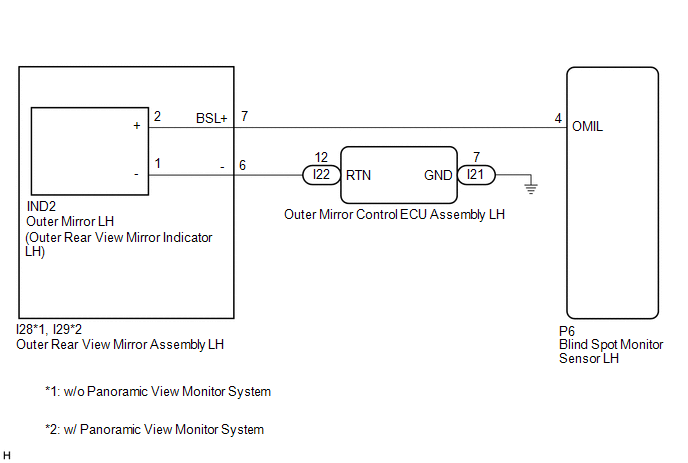
CAUTION / NOTICE / HINT
NOTICE:
When checking for DTCs, make sure that the blind spot monitor system is turned on.
PROCEDURE
(a) Turn the engine switch off.
(b) Turn the engine switch on (IG).
(c) Recheck for DTCs and check if the same DTC is output again.
Body Electrical > Blind Spot Monitor Slave > Trouble Codes
OK:
No DTCs are output.
|
Result | Proceed to |
|
OK | A |
|
NG (w/o Seat Memory) |
B |
| NG (w/ Seat Memory) |
C |
| A |
 | USE SIMULATION METHOD TO CHECK |
| C |
 | GO TO STEP 5 |
|
B |
 | |
| 2. |
CHECK HARNESS AND CONNECTOR (OUTER REAR VIEW MIRROR ASSEMBLY LH - BLIND SPOT MONITOR SENSOR LH AND BODY GROUND) |
(a) Disconnect the P6 blind spot monitor sensor LH connector.
(b) Disconnect the I28 outer rear view mirror assembly LH connector.
(c) Measure the resistance according to the value(s) in the table below.
Standard Resistance:
|
Tester Connection | Condition |
Specified Condition |
|
P6-4 (OMIL) - I28-7 (BSL+) |
Always | Below 1 Ω |
|
I28-6 (-) - Body ground |
Always | Below 1 Ω |
| NG |
 | REPAIR OR REPLACE HARNESS OR CONNECTOR |
|
OK |
 | |
| 3. |
INSPECT OUTER REAR VIEW MIRROR ASSEMBLY LH |
(a) Disconnect the IND2 outer mirror LH connector.
(b) Measure the resistance according to the value(s) in the table below.
Standard Resistance:
|
Tester Connection | Condition |
Specified Condition |
|
I28-7 (BSL+) - IND2-2 (+) |
Always | Below 1 Ω |
|
I28-6 (-) - IND2-1 (-) |
Always | Below 1 Ω |
| NG |
 | REPLACE OUTER REAR VIEW MIRROR ASSEMBLY LH |
|
OK |
 | |
| 4. |
INSPECT OUTER MIRROR LH |
(a) Remove the outer mirror LH.
Click here 
(b) Inspect the outer rear view mirror indicator LH on the outer mirror LH.
Click here 
| OK |
 | REPLACE BLIND SPOT MONITOR SENSOR LH |
| NG |
 | REPLACE OUTER MIRROR LH |
| 5. |
CHECK HARNESS AND CONNECTOR (OUTER REAR VIEW MIRROR ASSEMBLY LH - BLIND SPOT MONITOR SENSOR LH) |
(a) Disconnect the P6 blind spot monitor sensor LH connector.
(b) Disconnect the I28*1 or I29*2 outer rear view mirror assembly LH connector.
(c) Measure the resistance according to the value(s) in the table below.
Standard Resistance:
|
Tester Connection | Condition |
Specified Condition |
|
P6-4 (OMIL) - I28-7 (BSL+)*1 |
Always | Below 1 Ω |
|
P6-4 (OMIL) - I29-7 (BSL+)*2 |
Always | Below 1 Ω |
- *1: w/o Panoramic View Monitor System
- *2: w/ Panoramic View Monitor System
| NG |
 | REPAIR OR REPLACE HARNESS OR CONNECTOR |
|
OK |
 | |
| 6. |
CHECK HARNESS AND CONNECTOR (OUTER REAR VIEW MIRROR ASSEMBLY LH - OUTER MIRROR CONTROL ECU ASSEMBLY LH AND BODY GROUND) |
(a) Disconnect the I28*1 or I29*2 outer rear view mirror assembly LH connector.
(b) Disconnect the I22 and I21 outer mirror control ECU assembly LH connectors.
(c) Measure the resistance according to the value(s) in the table below.
Standard Resistance:
|
Tester Connection | Condition |
Specified Condition |
|
I28-6 (-) - I22-12 (RTN)*1 |
Always | Below 1 Ω |
|
I29-6 (-) - I22-12 (RTN)*2 |
Always | Below 1 Ω |
|
I21-7 (GND) - Body ground |
Always | Below 1 Ω |
- *1: w/o Panoramic View Monitor System
- *2: w/ Panoramic View Monitor System
| NG |
 | REPAIR OR REPLACE HARNESS OR CONNECTOR |
|
OK |
 | |
| 7. |
INSPECT OUTER MIRROR CONTROL ECU ASSEMBLY LH |
(a) Disconnect the I21 and I22 outer mirror control ECU assembly LH connectors.
| (b) Measure the resistance according to the value(s) in the table below.
Standard Resistance: |
Tester Connection | Condition |
Specified Condition | |
I21-7 (GND) - I22-12 (RTN) |
Always | Below 1 Ω | |
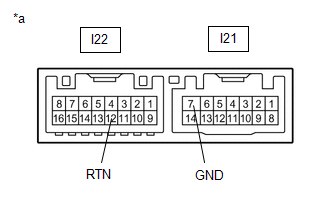 |
|
*a | Component without harness connected
(Outer Mirror Control ECU Assembly LH) | | |
| NG |
 | REPLACE OUTER MIRROR CONTROL ECU ASSEMBLY LH |
|
OK |
 | |
| 8. |
INSPECT OUTER REAR VIEW MIRROR ASSEMBLY LH |
(a) Disconnect the IND2 outer mirror LH connector.
(b) Measure the resistance according to the value(s) in the table below.
Standard Resistance:
|
Tester Connection | Condition |
Specified Condition |
|
I28-7 (BSL+) - IND2-2 (+)*1 |
Always | Below 1 Ω |
|
I28-6 (-) - IND2-1 (-)*1 |
Always | Below 1 Ω |
|
I29-7 (BSL+) - IND2-2 (+)*2 |
Always | Below 1 Ω |
|
I29-6 (-) - IND2-1 (-)*2 |
Always | Below 1 Ω |
- *1: w/o Panoramic View Monitor System
- *2: w/ Panoramic View Monitor System
| NG |
 | REPLACE OUTER REAR VIEW MIRROR ASSEMBLY LH |
|
OK |
 | |
| 9. |
INSPECT OUTER MIRROR LH |
(a) Remove the outer mirror LH.
Click here 
(b) Inspect the outer rear view mirror indicator LH on the outer mirror LH.
Click here 
| OK |
 | REPLACE BLIND SPOT MONITOR SENSOR LH |
| NG |
 | REPLACE OUTER MIRROR LH |
Blind Spot Monitor Master Module (C1AB6)
DESCRIPTION
This DTC is stored when the blind spot monitor sensor RH detects an internal malfunction.
|
DTC No. | Detection Item |
DTC Detection Condition | Trouble Area |
|
C1AB6 | Blind Spot Monitor Master Module |
The blind spot monitor sensor RH (master) detects an internal malfunction |
Blind spot monitor sensor RH |
CAUTION / NOTICE / HINT
NOTICE:
When checking for DTCs, make sure that the blind spot monitor system is turned on.
PROCEDURE
(a) Turn the engine switch off.
(b) Turn the engine switch on (IG).
(c) Recheck for DTCs and check if the same DTC is output again.
Body Electrical > Blind Spot Monitor Master > Trouble Codes
OK:
No DTCs are output.
| OK |  |
USE SIMULATION METHOD TO CHECK |
| NG |
 | REPLACE BLIND SPOT MONITOR SENSOR RH |
Blind Spot Monitor Slave Module (C1AB7)
DESCRIPTION
This DTC is stored when the blind spot monitor sensor LH detects an internal malfunction.
|
DTC No. | Detection Item |
DTC Detection Condition | Trouble Area |
|
C1AB7 | Blind Spot Monitor Slave Module |
The blind spot monitor sensor LH (slave) detects an internal malfunction |
Blind spot monitor sensor LH |
CAUTION / NOTICE / HINT
NOTICE:
When checking for DTCs, make sure that the blind spot monitor system is turned on.
PROCEDURE
(a) Turn the engine switch off.
(b) Turn the engine switch on (IG).
(c) Recheck for DTCs and check if the same DTC is output again.
Body Electrical > Blind Spot Monitor Slave > Trouble Codes
OK:
No DTCs are output.
| OK |  |
USE SIMULATION METHOD TO CHECK |
| NG |
 | REPLACE BLIND SPOT MONITOR SENSOR LH |
Destination Information Undefined (C1AB8)
DESCRIPTION
This DTC is
stored when correct destination information is not sent from the main
body ECU (multiplex network body ECU) and destination information cannot
be confirmed after a blind spot monitor sensor has been replaced.
Blind Spot Monitor Master |
DTC No. | Detection Item |
DTC Detection Condition | Trouble Area |
|
C1AB8 | Destination Information Undefined |
The blind spot monitor sensor cannot communicate with the main body ECU |
- CAN communication system
- Main body ECU (multiplex network body ECU)
- Blind spot monitor sensor RH
|
Blind Spot Monitor Slave |
DTC No. | Detection Item |
DTC Detection Condition | Trouble Area |
|
C1AB8 | Destination Information Undefined |
The blind spot monitor sensor cannot communicate with the main body ECU |
- CAN communication system
- Main body ECU (multiplex network body ECU)
- Blind spot monitor sensor LH
|
CAUTION / NOTICE / HINT
NOTICE:
PROCEDURE
(a) Check for CAN communication system DTCs.
Click here 
OK:
CAN communication system DTCs are not output.
| NG |
 | GO TO CAN COMMUNICATION SYSTEM |
|
OK |
 | |
| 2. |
REPLACE MAIN BODY ECU (MULTIPLEX NETWORK BODY ECU) |
(a) Replace the main body ECU (multiplex network body ECU) with a new or known good one.
Click here 
|
NEXT |
 | |
(a) Recheck for DTCs and check if the same DTC is output again.
Body Electrical > Blind Spot Monitor Master > Trouble Codes Body
Electrical > Blind Spot Monitor Slave > Trouble Codes
|
Result | Proceed to |
|
No DTCs are output | A |
|
DTC C1AB8 is output ("Blind Spot Monitor Master") |
B |
| DTC C1AB8 is output ("Blind Spot Monitor Slave") |
C |
| A |
 | END |
| B |
 | REPLACE BLIND SPOT MONITOR SENSOR RH |
| C |
 | REPLACE BLIND SPOT MONITOR SENSOR LH |
Blind Spot Monitor Master Module Beam Axis Inspection Incomplete (C1ABB)
DESCRIPTION
This DTC is stored when a beam axis inspection has not been performed for the blind spot monitor sensor RH.
HINT:
This
DTC is always stored after replacing a blind spot monitor sensor. The
purpose of this DTC is to ensure that a beam axis inspection is
performed. Completing the beam axis inspection after replacing a blind
spot monitor sensor prevents this DTC from being output.
|
DTC No. | Detection Item |
DTC Detection Condition | Trouble Area |
|
C1ABB | Blind Spot Monitor Master Module Beam Axis Inspection Incomplete |
A beam axis inspection has not been performed |
Blind spot monitor sensor RH |
PROCEDURE
| 1. |
PROCEED TO TEST MODE (BLIND SPOT MONITOR BEAM AXIS INSPECTION) |
(a) Change the blind spot monitor sensor RH to Test Mode using the Techstream.
HINT:
Refer to Blind Spot Monitor Beam Axis Inspection.
Click here

| NEXT |  |
END |
Blind Spot Monitor Slave Module Beam Axis Inspection Incomplete (C1ABC)
DESCRIPTION
This DTC is stored when a beam axis inspection has not been performed for the blind spot monitor sensor LH.
HINT:
This
DTC is always stored after replacing a blind spot monitor sensor. The
purpose of this DTC is to ensure that a beam axis inspection is
performed. Completing the beam axis inspection after replacing a blind
spot monitor sensor prevents this DTC from being output.
|
DTC No. | Detection Item |
DTC Detection Condition | Trouble Area |
|
C1ABC | Blind Spot Monitor Slave Module Beam Axis Inspection Incomplete |
A beam axis inspection has not been performed |
Blind spot monitor sensor LH |
PROCEDURE
| 1. |
PROCEED TO TEST MODE (BLIND SPOT MONITOR BEAM AXIS INSPECTION) |
(a) Change the blind spot monitor sensor LH to Test Mode using the Techstream.
HINT:
Refer to Blind Spot Monitor Beam Axis Inspection.
Click here

| NEXT |  |
END |
Short to GND or Open in Buzzer (C1ABE)
DESCRIPTION
- DTC C1ABE is stored when the blind spot monitor sensor LH detects a
short to ground or open in the RCTA buzzer (blind spot monitor buzzer)
circuit.
|
DTC No. | Detection Item |
DTC Detection Condition | Trouble Area |
|
C1ABE | Short to GND or Open in Buzzer | Both of the following conditions are met:
- The blind spot monitor system is on
- The blind spot monitor sensor is not sounding the buzzer but the buzzer
receives voltage below a specified level for a specified period of time.
|
- RCTA buzzer (blind spot monitor buzzer)
- Wire harness or connector
|
WIRING DIAGRAM
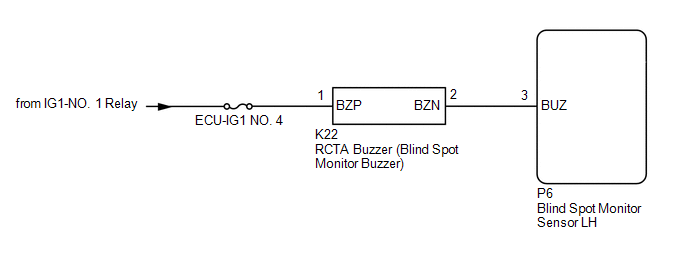
CAUTION / NOTICE / HINT
NOTICE:
- When checking for DTCs, make sure that the blind spot monitor system is turned on.
- Inspect the fuses for circuits related to this system before performing the following procedure.
PROCEDURE
|
1. | READ VALUE USING TECHSTREAM (BLIND SPOT MONITOR SENSOR LH STATUS) |
(a) Connect the Techstream to the DLC3.
(b) Turn the engine switch on (IG).
(c) Turn the Techstream on.
(d) Enter the following menus: Body Electrical / Blind Spot Monitor Slave / Data List.
(e) Read the Data List according to the display on the Techstream.
Body Electrical > Blind Spot Monitor Slave > Data List
|
Tester Display | Measurement Item |
Range | Normal Condition |
Diagnostic Note |
|
Buzzer Connection | Status of the buzzer connection |
Valid or Invalid | Valid: Buzzer connection is valid
Invalid: Buzzer connection is invalid |
- |
| Slave Side RCTA Function |
Switches the RCTA function on and off |
OFF or ON | OFF: RCTA function off
ON: RCTA function on |
- |
Body Electrical > Blind Spot Monitor Slave > Data List
|
Tester Display |
| Buzzer Connection |
|
Slave Side RCTA Function |
|
Result | Proceed to |
|
"Valid" and "ON" is displayed for all items. |
A |
| "Invalid" or "OFF" is displayed. |
B |
| B |
 | REPLACE BLIND SPOT MONITOR SENSOR LH |
|
A |
 | |
(a) Turn the engine switch off.
(b) Turn the engine switch on (IG).
(c) Recheck for DTCs and check if the same DTC is output again.
Body Electrical > Blind Spot Monitor Slave > Trouble Codes
OK:
No DTCs are output.
| OK |  |
USE SIMULATION METHOD TO CHECK |
|
NG |
 | |
| 3. |
CHECK HARNESS AND CONNECTOR (RCTA BUZZER - BATTERY AND BLIND SPOT MONITOR SENSOR LH) |
(a) Disconnect the K22 RCTA buzzer (blind spot monitor buzzer) connector.
(b) Disconnect the P6 blind spot monitor sensor LH connector.
(c) Measure the resistance according to the value(s) in the table below.
Standard Resistance:
|
Tester Connection | Condition |
Specified Condition |
|
K22-2 (BZN) - P6-3 (BUZ) |
Always | Below 1 Ω |
|
K22-2 (BZN) or P6-3 (BUZ) - Body ground |
Always | 10 kΩ or higher |
(d) Measure the voltage according to the value(s) in the table below.
Standard Voltage:
|
Tester Connection | Condition |
Specified Condition |
|
K22-1 (BZP) - Body ground |
Engine switch on (IG) |
11 to 14 V |
|
K22-1 (BZP) - Body ground |
Engine switch off | Below 1 V |
| OK |
 | REPLACE RCTA BUZZER (BLIND SPOT MONITOR BUZZER) |
| NG |
 | REPAIR OR REPLACE HARNESS OR CONNECTOR |
Master Module Horizontal Axis Misalignment (C1AC1)
DESCRIPTION
This DTC is
stored when the angle of the blind spot monitor sensor RH deviates more
than the allowable range from the horizontal axis.
HINT:
- If a drum tester such as a speedometer tester, brake/speedometer
combination tester or chassis dynamometer is used with the blind spot
monitor system on, the blind spot monitor sensor may store this DTC by
mistake.
- When mud, snow, ice, a sticker, etc. is covering the sensor or its
surrounding area on the rear bumper, the blind spot monitor sensor may
store this DTC by mistake.
|
DTC No. | Detection Item |
DTC Detection Condition | Trouble Area |
|
C1AC1 | Master Module Horizontal Axis Misalignment |
When the blind spot monitor sensor deviates 5 degrees or more from the horizontal axis when the system is activated |
Blind spot monitor sensor RH |
CAUTION / NOTICE / HINT
NOTICE:
PROCEDURE
|
1. | CHECK VEHICLE CONDITION |
(a) Check the condition of the rear bumper around the blind spot monitor sensors.
HINT:
When
mud, snow, ice, a sticker, etc. is covering the sensor or its
surrounding area on the rear bumper, the blind spot monitor sensor may
store this DTC by mistake.
|
Result | Proceed to |
|
A sticker, mud, snow, ice, etc. is covering the sensor or surrounding area on the rear bumper. |
A |
| There are scratches or dents on the rear bumper around the sensors. |
B |
| No abnormalities. |
| B |
 | GO TO STEP 3 |
|
A |
 | |
| 2. |
PERFORM BEAM AXIS CONFIRMATION |
(a) Clean the rear bumper.
(b) Perform Blind Spot Monitor Beam Axis Confirmation using the Techstream.
Click here 
Body Electrical > Blind Spot Monitor Master > Utility
|
Tester Display |
| BSM Master Beam Axis Display |
Body Electrical > Blind Spot Monitor Master > Utility
|
Tester Display |
| BSM Master Beam Axis Adjustment |
| OK |
 | END |
| NG |
 | REPLACE BLIND SPOT MONITOR SENSOR RH |
| 3. |
CHECK INSTALLATION CONDITION |
(a) Check the installation condition of the blind spot monitor sensor RH.
Click here 
HINT:
Take the appropriate action in accordance with the result.
|
NEXT |
 | |
| 4. |
PERFORM BEAM AXIS CONFIRMATION |
(a) Install the rear bumper.
Click here 
(b) Perform Blind Spot Monitor Beam Axis Confirmation using the Techstream.
Click here 
Body Electrical > Blind Spot Monitor Master > Utility
|
Tester Display |
| BSM Master Beam Axis Display |
Body Electrical > Blind Spot Monitor Master > Utility
|
Tester Display |
| BSM Master Beam Axis Adjustment |
| OK |
 | END |
| NG |
 | REPLACE BLIND SPOT MONITOR SENSOR RH |
Slave Module Horizontal Axis Misalignment (C1AC2)
DESCRIPTION
This DTC is
stored when the angle of the blind spot monitor sensor LH deviates more
than the allowable range from the horizontal axis.
HINT:
- If a drum tester such as a speedometer tester, brake/speedometer
combination tester or chassis dynamometer is used with the blind spot
monitor system on, the blind spot monitor sensor may store this DTC by
mistake.
- When mud, snow, ice, a sticker, etc. is covering the sensor or its
surrounding area on the rear bumper, the blind spot monitor sensor may
store this DTC by mistake.
|
DTC No. | Detection Item |
DTC Detection Condition | Trouble Area |
|
C1AC2 | Slave Module Horizontal Axis Misalignment |
When the blind spot monitor sensor deviates 5 degrees or more from the horizontal axis when the system is activated |
Blind spot monitor sensor LH |
CAUTION / NOTICE / HINT
NOTICE:
- When checking for DTCs, make sure that the blind spot monitor system is turned on.
- If the bumper is damaged or the vehicle has a history of body repair,
there is a possibility that the installation area of the blind spot
monitor sensor may be deformed and the blind spot monitor sensor system
may not operate correctly, so visually inspect the blind spot monitor
sensor installation area (frame, stud bolt) to make sure it is not
dented or bent.
Click here 
If
the results are not as specified, it is possible that the blind spot
monitor sensor installation area (frame, stud bolt) is deformed, so make
corrections as necessary.
PROCEDURE
|
1. | CHECK VEHICLE CONDITION |
(a) Check the condition of the rear bumper around the blind spot monitor sensors.
HINT:
When
mud, snow, ice, a sticker, etc. is covering the sensor or its
surrounding area on the rear bumper, the blind spot monitor sensor may
store this DTC by mistake.
|
Result | Proceed to |
|
A sticker, mud, snow, ice, etc. is covering the sensor or surrounding area on the rear bumper. |
A |
| There are scratches or dents on the rear bumper around the sensors. |
B |
| No abnormalities. |
| B |
 | GO TO STEP 3 |
|
A |
 | |
| 2. |
PERFORM BEAM AXIS CONFIRMATION |
(a) Clean the rear bumper.
(b) Perform Blind Spot Monitor Beam Axis Confirmation using the Techstream.
Click here 
Body Electrical > Blind Spot Monitor Slave > Utility
|
Tester Display |
| BSM Slave Beam Axis Display |
Body Electrical > Blind Spot Monitor Slave > Utility
|
Tester Display |
| BSM Slave Beam Axis Adjustment |
| OK |
 | END |
| NG |
 | REPLACE BLIND SPOT MONITOR SENSOR LH |
| 3. |
CHECK INSTALLATION CONDITION |
(a) Check the installation condition of the blind spot monitor sensor LH.
Click here 
HINT:
Take the appropriate action in accordance with the result.
|
NEXT |
 | |
| 4. |
PERFORM BEAM AXIS CONFIRMATION |
(a) Install the rear bumper.
Click here 
(b) Perform Blind Spot Monitor Beam Axis Confirmation using the Techstream.
Click here 
Body Electrical > Blind Spot Monitor Slave > Utility
|
Tester Display |
| BSM Slave Beam Axis Display |
Body Electrical > Blind Spot Monitor Slave > Utility
|
Tester Display |
| BSM Slave Beam Axis Adjustment |
| OK |
 | END |
| NG |
 | REPLACE BLIND SPOT MONITOR SENSOR LH |
Customize Parameters
CUSTOMIZE PARAMETERS
CUSTOMIZE BLIND SPOT MONITOR SYSTEM
(a) Customizing with the Techstream
NOTICE:
- When the customer requests a change in a function, first make sure that the function can be customized.
- Be sure to make a note of the current settings before customizing.
- When troubleshooting a function, first make sure that the function is set to the default setting.
(1) Connect the Techstream to the DLC3.
(2) Turn the engine switch to ON.
(3) Turn the blind spot monitor system on.
(4) Turn the Techstream on.
(5) Enter the following menus: Body Electrical / Blind Spot Monitor Master or Blind Spot Monitor Slave / Utility / Warning.
(6) Select the setting by referring to the table below.
Warning
|
Tester Display | Description |
Default | Setting |
ECU |
| BSM Buzzer Volume Adjust |
Sets the volume of the RCTA buzzer (blind spot monitor buzzer). |
Medium | 001:Low,011:Medium,101:High |
Blind Spot Monitor Sensor LH |
|
BSM Mirror Indicator Brightness |
Sets the brightness of the indicators in the outer rear view mirror assemblies. |
Bright | 001:Dark,101:Bright |
Blind Spot Monitor Sensor RH |
|
RCTA Function | Switches the RCTA function on and off.* |
ON | 0:ON,1:OFF |
Blind Spot Monitor Sensor RH |
- *: If the RCTA function is turned off, the RCTAB function of the intelligent clearance sonar system also turns off.
Data List / Active Test
DATA LIST / ACTIVE TEST
DATA LIST
NOTICE:
In
the table below, the values listed under "Normal Condition" are
reference values. Do not depend solely on these reference values when
deciding whether a part is faulty or not.
HINT:
Using
the Techstream to read the Data List allows the values or states of
switches, sensors, actuators and other items to be read without removing
any parts. This non-intrusive inspection can be very useful because
intermittent conditions or signals may be discovered before parts or
wiring is disturbed. Reading the Data List information early in
troubleshooting is one way to save diagnostic time.
(a) Connect the Techstream to the DLC3.
(b) Turn the engine switch on (IG).
(c) Turn the Techstream on.
(d) Enter the following menus: Body Electrical / Blind Spot Monitor Master or Blind Spot Monitor Slave / Data List.
(e) Read the Data List according to the display on the Techstream.
Body Electrical > Blind Spot Monitor Master > Data List
|
Tester Display | Measurement Item |
Range | Normal Condition |
Diagnostic Note |
|
Main Switch | State of the Blind spot monitor system |
OFF or ON | OFF: Blind spot monitor system off
ON: Blind spot monitor system on |
- |
| RCTA Switch Status |
State of the RCTA function |
OFF or ON | OFF: RCTA function off
ON: RCTA function on |
- |
| Warning Indicator Turning on(Master) |
State of the outer rear view mirror indicator RH turning on |
OFF or ON |
- OFF: Any state except "ON" state
- ON: Either of the following state
- During initial check
- Blind spot monitor system on, vehicle detected on left hand side and turn signal switch not operated
| - |
|
Warning Indicator Flashing(Master) |
State of the outer rear view mirror indicator RH flashing |
OFF or ON |
- OFF: Any state except "ON" state
- ON: Either of the following state
- Blind spot monitor system on, vehicle detected on left hand side and left side of turn signal switch on
- Vehicle detected by RCTA function
| - |
|
Warning Indicator Input Circuit Voltage |
Outer rear view mirror indicator voltage |
Min.: 0 V, Max.: 25.5 V |
Indicator illuminated: 2.5 to 7.5 V Indicator not illuminated: Below 1 V |
- |
| Warning Indicator Input Circuit Current |
Outer rear view mirror indicator current |
Min.: 0 mA, Max.: 255 mA |
Indicator illuminated: 5 to 100 mA Indicator not illuminated: 0 mA |
- |
| Turn Switch State |
State of the turn signal switch |
Left ON, Right ON or OFF |
Left ON: Left turn signal switch on Right ON: Right turn signal switch on
OFF: Turn signal switch off |
- |
| Reverse (Only for AT/CVT) |
State of the shift position R signal |
OFF or ON | OFF: Shift lever in any position except R
ON: Shift lever in R |
- |
| Vehicle Speed |
Vehicle speed signal | Min.: -327.68 km/h (-204 mph), Max.: 327.67 km/h (204 mph) |
Vehicle stopped: 0 km/h (0 mph) |
- |
| Steering Angle |
Steering sensor | Min.: -3072 deg, Max.: 3070.5 deg |
Left turn: Increases Right turn: Decreases |
- |
| Power Supply Voltage |
Power supply voltage | Min.: 0 V, Max.: 49.951 V |
Engine switch on (IG): 11 to 14 V |
- |
| Indicator Light Control State |
Outer rear view mirror indicator dimming state |
Dim OFF or Dim ON | Dim OFF: Indicator not dimmed
Dim ON: Indicator dimmed |
- |
| HV Flag |
Hybrid vehicle | OFF or ON |
OFF: Non-hybrid vehicle ON: Hybrid vehicle |
- |
| VGRS Flag |
VGRS installed | OFF or ON |
OFF: VGRS not installed ON: VGRS installed |
- |
| Beam Axis Inspection Completeness Flag |
Completion of beam axis adjustment |
Incompl or Compl | Incompl: Adjustment not completed
Compl: Adjustment completed |
Changes to "Compl" when blind spot monitor beam axis adjustment has been finished |
|
Destination Undefined Flag |
Destination determination |
Unfixed or Fixed | Unfixed: Sensor destination information not determined
Fixed: Sensor destination information determined according to CAN destination information |
- |
| Angle Adjustment by Auto Alignment |
Angle adjusted using auto alignment |
Min.: Under -180 deg, Max.: Over 180 deg |
Angle adjusted using auto alignment is displayed |
- |
| RCTA Equipped Information |
State of the RCTA equipped information / OFF or ON |
OFF or ON | OFF: w/o RCTA function
ON: w/ RCTA function |
- |
| Master Side RCTA Function |
Switches the RCTA function on and off |
OFF or ON | ON: RCTA function on
OFF: RCTA function off |
- |
| Mirror LED Control Frequency |
Frequency of the outer rear view mirror indicator on the outer mirror when blinking |
Min.: 1500 Hz, Max.: 2400 Hz |
Always: 2000 Hz | - |
|
Setting of Warning Indicator Current (Dim OFF) |
Set current of the outer rear view mirror indicator when not dimmed |
Min.: 0 mA, Max.: 100 mA |
Always: 0 to 100 mA | - |
|
Setting of Warning Indicator Current (Dim ON) |
Set current of the outer rear view mirror indicator when dimmed |
Min.: 0 mA, Max.: 100 mA |
Always: 0 to 100 mA | - |
|
Mirror LED Duty Ratio (Blinking) |
Duty ratio of the outer rear view mirror indicator when blinking |
Min.: 0%, Max.: 100% | Always: 50 % |
- |
| Yaw Rate Sensor |
Yaw rate sensor | Min.: Under -125 deg/s, Max.: 124.612 deg/s |
Turning right: -125 to 0 deg/s Turning left: 0 to 124.612 deg/s |
- |
| Master Side BSM Approaching Vehicle Detection Timing Setting |
Notification timing for vehicles approaching from behind the vehicle |
Only Blind Spot, Late, Middle or Early |
Only Blind Spot: Only detection area (for vehicle in blind spot) is active
Late: Late notification Middle: Default notification timing
Early: Early notification |
- |
| BSM Mirror Indicator Brightness |
Brightness of the indicators in the outer rear view mirror assemblies |
Dark or Bright | Dark: Outer mirror indicator brightness low
Dark: Outer mirror indicator brightness low |
- |
| Mounting FHL Function |
Existence of FHL function |
Without or With | Without: w/o FHL function
With: w/ FHL function |
- |
| Number of DTC |
Number of DTC | Min.: 0, Max.: 255 |
When system is normal: 0 When a malfunction is detected: More than 0 |
- |
Body Electrical > Blind Spot Monitor Slave > Data List
|
Tester Display | Measurement Item |
Range | Normal Condition |
Diagnostic Note |
|
Warning Indicator Turning on(Slave) |
State of the outer rear view mirror indicator LH turning on |
OFF or ON |
- OFF: Any state except "ON" state
- ON: Either of the following state
- During initial check
- Blind spot monitor system on, vehicle detected on right hand side and turn signal switch not operated
| - |
|
Warning Indicator Flashing(Slave) |
State of the outer rear view mirror indicator LH flashing |
OFF or ON |
- OFF: Any state except "ON" state
- ON: Either of the following state
- Blind spot monitor system on, vehicle detected on right hand side and right side of turn signal switch on
- Vehicle detected by RCTA function
| - |
|
Buzzer Sound Status | State of the RCTA buzzer (blind spot monitor buzzer) |
OFF or ON | OFF: Buzzer not sounding
ON: Buzzer sounding | - |
|
Warning Indicator Input Circuit Voltage |
Outer rear view mirror indicator voltage |
Min.: 0 V, Max.: 25.5 V |
Indicator illuminated: 2.5 to 7.5 V Indicator not illuminated: Below 1 V |
- |
| Warning Indicator Input Circuit Current |
Outer rear view mirror indicator current |
Min.: 0 mA, Max.: 255 mA |
Indicator illuminated: 5 to 100 mA Indicator not illuminated: 0 mA |
- |
| Buzzer Input Circuit Voltage |
RCTA buzzer (blind spot monitor buzzer) voltage |
Min.: 0 V, Max.: 25.5 V |
Buzzer not sounding: 11 to 14 V Buzzer sounding: Alternating between 0 to 14 V |
- |
| Turn Switch State |
State of the turn signal switch |
Left ON, Right ON or OFF |
Left ON: Left turn signal switch on Right ON: Right turn signal switch on
OFF: Turn signal switch off |
- |
| Reverse (Only for AT/CVT) |
State of the shift position R signal |
OFF or ON | OFF: Shift lever in any position except R
ON: Shift lever in R |
- |
| Vehicle Speed |
Vehicle speed signal | Min.: -327.68 km/h (-204 mph), Max.: 327.67 km/h (204 mph) |
Vehicle stopped: 0 km/h (0 mph) |
- |
| Steering Angle |
Steering sensor | Min.: -3072 deg, Max.: 3070.5 deg |
Left turn: Increases Right turn: Decreases |
- |
| Power Supply Voltage |
Power supply voltage | Min.: 0 V, Max.: 49.951 V |
Engine switch on (IG): 11 to 14 V |
- |
| Indicator Light Control State |
Outer rear view mirror indicator dimming state |
Dim OFF or Dim ON | Dim OFF: Indicator not dimmed
Dim ON: Indicator dimmed |
- |
| HV Flag |
Hybrid vehicle | OFF or ON |
OFF: Non-hybrid vehicle ON: Hybrid vehicle |
- |
| VGRS Flag |
VGRS installed | OFF or ON |
OFF: VGRS not installed ON: VGRS installed |
- |
| Beam Axis Inspection Completeness Flag |
Completion of beam axis adjustment |
Incompl or Compl | Incompl: Adjustment not completed
Compl: Adjustment completed |
Changes to "Compl" when blind spot monitor beam axis adjustment has been finished |
|
Destination Undefined Flag |
Destination determination |
Unfixed or Fixed | Unfixed: Sensor destination information not determined
Fixed: Sensor destination information determined according to CAN destination information |
- |
| Angle Adjustment by Auto Alignment |
Angle adjusted using auto alignment |
Min.: Under -180 deg, Max.: Over 180 deg |
Angle adjusted using auto alignment is displayed |
- |
| RCTA Equipped Information |
State of the RCTA equipped information / OFF or ON |
OFF or ON | OFF: w/o RCTA function
ON: w/ RCTA function |
- |
| Slave Side RCTA Function |
Switches the RCTA function on and off |
OFF or ON | OFF: RCTA function off
ON: RCTA function on |
- |
| Mirror LED Control Frequency |
Frequency of the outer rear view mirror indicator on the outer mirror when blinking |
Min.: 1500 Hz, Max.: 2400 Hz |
Always: 2000 Hz | - |
|
Setting of Warning Indicator Current (Dim OFF) |
Set current of the outer rear view mirror indicator when not dimmed |
Min.: 0 mA, Max.: 100 mA |
Always: 0 to 100 mA | - |
|
Setting of Warning Indicator Current (Dim ON) |
Set current of the outer rear view mirror indicator when dimmed |
Min.: 0 mA, Max.: 100 mA |
Always: 0 to 100 mA | - |
|
Mirror LED Duty Ratio (Blinking) |
Duty ratio of the outer rear view mirror indicator when blinking |
Min.: 0%, Max.: 100% | Always: 50% |
- |
| Buzzer Control Frequency |
Frequency of RCTA buzzer (blind spot monitor buzzer) when sounding |
Min.: 1000 Hz, Max.: 2400 Hz |
Always: 2000 Hz | - |
|
Yaw Rate Sensor | Yaw rate sensor |
Min.: Under -125 deg/s, Max.: 124.612 deg/s |
Turning right: -125 to 0 deg/s Turning left: 0 to 124.612 deg/s |
- |
| BSM Buzzer Volume Adjust |
Volume of the RCTA buzzer (blind spot monitor buzzer) |
Low, Medium or High | Low: Buzzer volume less than that of medium
Medium: Default buzzer volume High: Buzzer volume more than that of medium |
- |
| Mounting FHL Function |
Existence of FHL function |
Without or With | Without: w/o FHL function
With: w/ FHL function |
- |
| Number of DTC |
Number of DTC | Min.: 0, Max.: 255 |
When system is normal: 0 When a malfunction is detected: More than 0 |
- |
Diagnosis System
DIAGNOSIS SYSTEM
DESCRIPTION
(a)
Blind spot monitor data and Diagnostic Trouble Codes (DTCs) can be read
from the Data Link Connector 3 (DLC3) of the vehicle. When the system
seems to be malfunctioning, use the Techstream to check for malfunctions
and perform repairs.
CHECK DLC3
(a) Check the DLC3.
Click here

DIAGNOSIS FUNCTION
(a)
The blind spot monitor system displays an error message on the
multi-information display to inform the driver that the system is
unavailable either temporarily or due to a malfunction.
(b)
The RCTA function displays an error message on the multi-information
display to inform the driver that the system is unavailable either
temporarily or due to a malfunction.
ABNORMALITY HISTORY
HINT:
The abnormality history for a blind spot monitor sensor can be displayed or cleared.
(a) Check abnormality history
(1) Connect the Techstream to the DLC3.
(2) Turn the engine switch on (IG).
(3) Turn the Techstream on.
(4) Turn the blind spot monitor system on.
(5)
Enter the following menus: Body Electrical / Blind Spot Monitor Master
or Blind Spot Monitor Slave / Utility / BSM Master Abnormal History or
BSM Slave Abnormal History.
Body Electrical > Blind Spot Monitor Master > Utility
|
Tester Display |
| BSM Master Abnormal History |
Body Electrical > Blind Spot Monitor Slave > Utility
|
Tester Display |
| BSM Slave Abnormal History |
(6) Check the results displayed for the abnormality history check.
HINT:
- If "Yes" is displayed, check the suspected area column for each item.
- Abnormality history is stored only for the blind spot monitor sensor for which an abnormality has been detected.
- If "No" is displayed, refer to Problem Symptoms Table.
Click here 
Abnormality History Table |
Tester Display | Item Explanation |
Suspected Area |
|
History of Module Blockage | History of blind spot monitor sensor detection problems due to snow, rain, etc. on the bumper |
- Check if a bumper compatible with the blind spot monitor (such as an original equipment bumper) is installed
- Check if any foreign matter is attached to the bumper
- Check if any foreign matter is present between the bumper and sensors
|
| History of Low Voltage |
History of low supply battery voltage from battery to the blind spot monitor sensor |
Power Source Circuit Click here
 |
|
History of High Voltage | History of high supply battery voltage from battery to the blind spot monitor sensor |
|
History of Low Temperature | History of low temperature for the blind spot monitor sensor |
- Check the outside temperature
- Check if any foreign matter is attached to the blind spot monitor sensors and their surrounding areas
|
| History of High Temperature |
History of high temperature for the blind spot monitor sensor |
(b) Clearing abnormality history
(1) Connect the Techstream to the DLC3.
(2) Turn the engine switch on (IG).
(3) Turn the Techstream on.
(4) Turn the blind spot monitor system on.
(5)
Enter the following menus: Body Electrical / Blind Spot Monitor Master
or Blind Spot Monitor Slave / Utility / BSM Master Abnormal History or
BSM Slave Abnormal History.
Body Electrical > Blind Spot Monitor Master > Utility
|
Tester Display |
| BSM Master Abnormal History |
Body Electrical > Blind Spot Monitor Slave > Utility
|
Tester Display |
| BSM Slave Abnormal History |
(6) Clear the abnormality history.
Diagnostic Trouble Code Chart
DIAGNOSTIC TROUBLE CODE CHART
Blind Spot Monitor System |
DTC No. | Detection Item |
Link |
| C1A45 |
Vehicle Speed Sensor |
 |
|
C1A45 | Vehicle Speed Sensor |
 |
|
C1A46 | Yaw Rate Sensor |
 |
|
C1A46 | Yaw Rate Sensor |
 |
|
C1A47 | Steering Angle Sensor |
 |
|
C1A47 | Steering Angle Sensor |
 |
|
C1AB0 | Short to +B in Outer Mirror Indicator(Master) |
 |
|
C1AB1 | Short to +B in Outer Mirror Indicator(Slave) |
 |
|
C1AB2 | Short to GND in Outer Mirror Indicator(Master) |
 |
|
C1AB3 | Short to GND in Outer Mirror Indicator(Slave) |
 |
|
C1AB4 | Open in Outer Mirror Indicator(Master) |
 |
|
C1AB5 | Open in Outer Mirror Indicator(Slave) |
 |
|
C1AB6 | Blind Spot Monitor Master Module |
 |
|
C1AB7 | Blind Spot Monitor Slave Module |
 |
|
C1AB8 | Destination Information Undefined |
 |
|
C1AB8 | Destination Information Undefined |
 |
|
C1ABB | Blind Spot Monitor Master Module Beam Axis Inspection Incomplete |
 |
|
C1ABC | Blind Spot Monitor Slave Module Beam Axis Inspection Incomplete |
 |
|
C1ABE | Short to GND or Open in Buzzer |
 |
|
C1AC1 | Master Module Horizontal Axis Misalignment |
 |
|
C1AC2 | Slave Module Horizontal Axis Misalignment |
 |
|
U0100 | Lost Communication with ECM / PCM "A" |
 |
|
U0100 | Lost Communication with ECM / PCM "A" |
 |
|
U0125 | Lost Communication with Yaw Rate Sensor Module |
 |
|
U0125 | Lost Communication with Yaw Rate Sensor Module |
 |
|
U0126 | Lost Communication with Steering Angle Sensor Module |
 |
|
U0126 | Lost Communication with Steering Angle Sensor Module |
 |
|
U0129 | Lost Communication with Brake System Control Module |
 |
|
U0129 | Lost Communication with Brake System Control Module |
 |
|
U0142 | Lost Communication with Body Control Module "B" |
 |
|
U0142 | Lost Communication with Body Control Module "B" |
 |
|
U0232 | Lost Communication with Blind Spot Monitor Slave Module |
 |
|
U0233 | Lost Communication with Blind Spot Monitor Master Module |
 |
|
U1331 | Software Incompatibility with Body Control Module "B" |
 |
|
U1331 | Software Incompatibility with Body Control Module "B" |
 |
Dtc Check / Clear
DTC CHECK / CLEAR
CHECK DTC
(a) Connect the Techstream to the DLC3.
(b) Turn the engine switch on (IG).
(c) Turn the blind spot monitor system on.
(d) Turn the Techstream on.
(e) Enter the following menus: Body Electrical / Blind Spot Monitor Master or Blind Spot Monitor Slave / Trouble Codes.
HINT:
The
blind spot monitor sensor RH and the blind spot monitor sensor LH both
output DTCs. Therefore, check both blind spot monitor sensors for DTCs.
Body Electrical > Blind Spot Monitor Master > Trouble Codes Body
Electrical > Blind Spot Monitor Slave > Trouble Codes (f) Check for DTCs.
Click here 
CLEAR DTC
(a) Connect the Techstream to the DLC3.
(b) Turn the engine switch on (IG).
(c) Turn the blind spot monitor system on.
(d) Turn the Techstream on.
(e) Enter the following menus: Body Electrical / Blind Spot Monitor Master or Blind Spot Monitor Slave / Trouble Codes.
Body Electrical > Blind Spot Monitor Master > Clear DTCs Body Electrical > Blind Spot Monitor Slave > Clear DTCs
(f) Clear the DTCs.
Freeze Frame Data
FREEZE FRAME DATA
FREEZE FRAME DATA
(a) Whenever DTCs are detected, the blind spot monitor sensor stores the current vehicle (sensor) state as freeze frame data.
CHECK FREEZE FRAME DATA
(a) Connect the Techstream to the DLC3.
(b) Turn the engine switch on (IG).
(c) Turn the blind spot monitor system on.
(d) Turn the Techstream on.
(e) Enter the following menus: Body Electrical / Blind Spot Monitor Master or Blind Spot Monitor Slave / Trouble Codes.
(f) According to the display on the Techstream, read the freeze frame data for the selected DTC.
Body Electrical > Blind Spot Monitor Master
|
Tester Display | Measurement Item |
Range | Normal Condition |
Diagnostic Note |
|
Main Switch | State of the Blind spot monitor system |
OFF or ON | OFF: Blind spot monitor system off
ON: Blind spot monitor system on |
- |
| RCTA Switch Status |
State of the RCTA function |
OFF or ON | OFF: RCTA function off
ON: RCTA function on |
- |
| Warning Indicator Turning on(Master) |
State of the outer rear view mirror indicator RH turning on |
OFF or ON |
- OFF: Any state except "ON" state
- ON: Either of the following state
- During initial check
- Blind spot monitor system on, vehicle detected on left hand side and turn signal switch not operated
| - |
|
Warning Indicator Flashing(Master) |
State of the outer rear view mirror indicator RH flashing |
OFF or ON |
- OFF: Any state except "ON" state
- ON: Either of the following state
- Blind spot monitor system on, vehicle detected on left hand side and left side of turn signal switch on
- Vehicle detected by RCTA function
| - |
|
Warning Indicator Input Circuit Voltage |
Outer rear view mirror indicator voltage |
Min.: 0 V, Max.: 25.5 V |
Indicator illuminated: 2.5 to 7.5 V Indicator not illuminated: Below 1 V |
- |
| Warning Indicator Input Circuit Current |
Outer rear view mirror indicator current |
Min.: 0 mA, Max.: 255 mA |
Indicator illuminated: 5 to 100 mA Indicator not illuminated: 0 mA |
- |
| Turn Switch State |
State of the turn signal switch |
Left ON, Right ON or OFF |
Left ON: Left turn signal switch on Right ON: Right turn signal switch on
OFF: Turn signal switch off |
- |
| Reverse (Only for AT/CVT) |
State of the shift position R signal |
OFF or ON | OFF: Shift lever in any position except R
ON: Shift lever in R |
- |
| Vehicle Speed |
Vehicle speed signal | Min.: -327.68 km/h (-204 mph), Max.: 327.67 km/h (204 mph) |
Vehicle stopped: 0 km/h (0 mph) |
- |
| Steering Angle |
Steering sensor | Min.: -3072 deg, Max.: 3070.5 deg |
Left turn: Increases Right turn: Decreases |
- |
| Power Supply Voltage |
Power supply voltage | Min.: 0 V, Max.: 49.951 V |
Engine switch on (IG): 11 to 14 V |
- |
| Indicator Light Control State |
Outer rear view mirror indicator dimming state |
Dim OFF or Dim ON | Dim OFF: Indicator not dimmed
Dim ON: Indicator dimmed |
- |
| Angle Adjustment by Auto Alignment |
Angle adjusted using auto alignment |
Min.: Under -180 deg, Max.: Over 180 deg |
Angle adjusted using auto alignment is displayed |
- |
| Yaw Rate Sensor |
Yaw rate sensor | Min.: Under -124.928 deg/s, Max.: 124.684 deg/s |
Turning right: -125 to 0 deg/s Turning left: 0 to 124.612 deg/s |
- |
| Number of DTC |
Number of DTC | Min.: 0, Max.: 255 |
When system is normal: 0 When a malfunction is detected: More than 0 |
- |
Body Electrical > Blind Spot Monitor Slave
|
Tester Display | Measurement Item |
Range | Normal Condition |
Diagnostic Note |
|
Warning Indicator Turning on(Slave) |
State of the outer rear view mirror indicator LH turning on |
OFF or ON |
- OFF: Any state except "ON" state
- ON: Either of the following state
- During initial check
- Blind spot monitor system on, vehicle detected on right hand side and turn signal switch not operated
| - |
|
Warning Indicator Flashing(Slave) |
State of the outer rear view mirror indicator LH flashing |
OFF or ON |
- OFF: Any state except "ON" state
- ON: Either of the following state
- Blind spot monitor system on, vehicle detected on right hand side and right side of turn signal switch on
- Vehicle detected by RCTA function
| - |
|
Buzzer Sound Status | State of the RCTA buzzer (blind spot monitor buzzer) |
OFF or ON | OFF: Buzzer not sounding
ON: Buzzer sounding | - |
|
Warning Indicator Input Circuit Voltage |
Outer rear view mirror indicator voltage |
Min.: 0 V, Max.: 25.5 V |
Indicator illuminated: 2.5 to 7.5 V Indicator not illuminated: Below 1 V |
- |
| Warning Indicator Input Circuit Current |
Outer rear view mirror indicator current |
Min.: 0 mA, Max.: 255 mA |
Indicator illuminated: 5 to 100 mA Indicator not illuminated: 0 mA |
- |
| Buzzer Input Circuit Voltage |
Buzzer Input Circuit Voltage |
Min.: 0 V, Max.: 25.5 V |
Engine switch on (IG): 11 to 14 V |
- |
| Turn Switch State |
State of the turn signal switch |
Left ON, Right ON or OFF |
Left ON: Left turn signal switch on Right ON: Right turn signal switch on
OFF: Turn signal switch off |
- |
| Reverse (Only for AT/CVT) |
State of the shift position R signal |
OFF or ON | OFF: Shift lever in any position except R
ON: Shift lever in R |
- |
| Vehicle Speed |
Vehicle speed signal | Min.: -327.68 km/h (-204 mph), Max.: 327.67 km/h (204 mph) |
Vehicle stopped: 0 km/h (0 mph) |
- |
| Steering Angle |
Steering sensor | Min.: -3072 deg, Max.: 3070.5 deg |
Left turn: Increases Right turn: Decreases |
- |
| VGRS Relative Angle |
Compensation value of steering angle calculated by VGRS |
Min.: -8.192 rad, Max.: 8.191 rad |
Left turn: Increases Right turn: Decreases |
- |
| Power Supply Voltage |
Power supply voltage | Min.: 0 V, Max.: 49.951 V |
Engine switch on (IG): 11 to 14 V |
- |
| Indicator Light Control State |
Outer rear view mirror indicator dimming state |
Dim OFF or Dim ON | Dim OFF: Indicator not dimmed
Dim ON: Indicator dimmed |
- |
| Angle Adjustment by Auto Alignment |
Angle adjusted using auto alignment |
Min.: Under -180 deg, Max.: Over 180 deg |
Angle adjusted using auto alignment is displayed |
- |
| Yaw Rate Sensor |
Yaw rate sensor | Min.: Under -124.928 deg/s, Max.: 124.684 deg/s |
Turning right: -125 to 0 deg/s Turning left: 0 to 124.612 deg/s |
- |
| Number of DTC |
Number of DTC | Min.: 0, Max.: 255 |
When system is normal: 0 When a malfunction is detected: More than 0 |
- |
CLEAR FREEZE FRAME DATA
NOTICE:
Clearing the DTCs will also clear the freeze frame data.
(a) Connect the Techstream to the DLC3.
(b) Turn the engine switch on (IG).
(c) Turn the blind spot monitor system on.
(d) Turn the Techstream on.
(e) Clear the DTCs and freeze frame data.
How To Proceed With Troubleshooting
CAUTION / NOTICE / HINT
HINT:
- Use the following procedure to troubleshoot the blind spot monitor system.
- *: Use the Techstream.
PROCEDURE
|
1. | VEHICLE BROUGHT TO WORKSHOP |
|
NEXT |
 | |
| 2. |
CUSTOMER PROBLEM ANALYSIS |
HINT:
If
there are any scratches or impact marks on the rear bumper, perform the
blind spot monitor beam axis confirmation. If any abnormalities are
found, perform the blind spot monitor sensor installation condition
inspection.
|
NEXT |
 | |
| 3. |
INSPECT BATTERY VOLTAGE |
(a) Measure the battery voltage.
Standard Voltage:
11 to 14 V
If the voltage is below 11 V, replace or recharge the battery before proceeding to the next step.
|
NEXT |
 | |
| 4. |
CHECK CAN COMMUNICATION SYSTEM* |
(a) Use the Techstream to check if the CAN communication system is functioning normally.
Click here 
|
Result | Proceed to |
|
CAN communication system DTCs are not output. |
A |
| CAN communication system DTCs are output. |
B |
| B |
 | GO TO CAN COMMUNICATION SYSTEM |
|
A |
 | |
| 5. |
CHECK FOR DTC AND FREEZE FRAME DATA* |
(a) Refer to DTC Check / Clear for the blind spot monitor system.
Body Electrical > Blind Spot Monitor Master > Trouble Codes Body
Electrical > Blind Spot Monitor Slave > Trouble Codes (b) Record or print DTCs and freeze frame data, if necessary.
Click here 
|
Result | Proceed to |
|
DTCs are not output. |
A |
| DTCs are output. |
B |
| B |
 | GO TO DIAGNOSTIC TROUBLE CODE CHART |
|
A |
 | |
| 6. |
PROBLEM SYMPTOMS TABLE |
(a) Refer to Problem Symptoms Table.
Click here 
|
Result | Proceed to |
|
Fault is not listed in Problem Symptoms Table. |
A |
| Fault is listed in Problem Symptoms Table. |
B |
HINT:
If the symptom does not recur and no DTCs are output, attempt to reproduce the symptoms.
Click here 
| B |
 | GO TO PROBLEM SYMPTOMS TABLE |
|
A |
 | |
| 7. |
PERFORM TROUBLESHOOTING BASED ON MALFUNCTION SYMPTOM* |
(a) Refer to Terminals of ECU.
Click here

(b) Refer to Diagnosis System.
Click here

(c) Refer to Data List / Active Test.
Click here 
|
NEXT |
 | |
| 8. |
ADJUST, REPAIR OR REPLACE |
|
Result | Proceed to |
|
When adjusting or repairing |
A |
| When replacing |
B |
| B |
 | GO TO STEP 10 |
|
A |
 | |
(a) Clear the DTCs.
Click here 
Body Electrical > Blind Spot Monitor Master > Clear DTCs Body Electrical > Blind Spot Monitor Slave > Clear DTCs
| NEXT |
 | GO TO STEP 10 |
| 10. |
PERFORM BEAM AXIS INSPECTION |
(a) Enter Test Mode (refer to Blind Spot Monitor Beam Axis Inspection).
Click here 
(b) Confirm the blind spot monitor beam axis display and perform the blind spot monitor beam axis adjustment.
|
NEXT |
 | |
| 11. |
PERFORM CONFIRMATION TEST* |
| NEXT |
 | END |
Parts Location
PARTS LOCATION
ILLUSTRATION
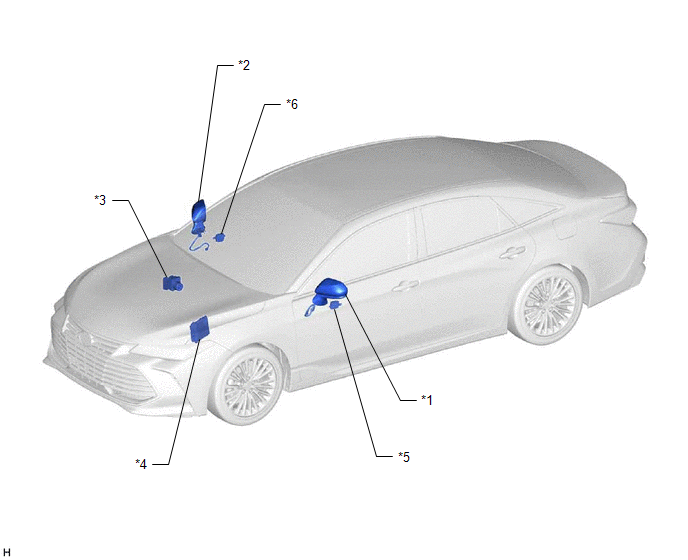
|
*1 | OUTER REAR VIEW MIRROR ASSEMBLY LH |
*2 | OUTER REAR VIEW MIRROR ASSEMBLY RH |
|
*3 | BRAKE ACTUATOR ASSEMBLY - SKID CONTROL ECU |
*4 | ECM |
|
*5 | OUTER MIRROR CONTROL ECU ASSEMBLY LH (w/ Seat Memory) |
*6 | OUTER MIRROR CONTROL ECU ASSEMBLY RH (w/ Seat Memory) |
ILLUSTRATION
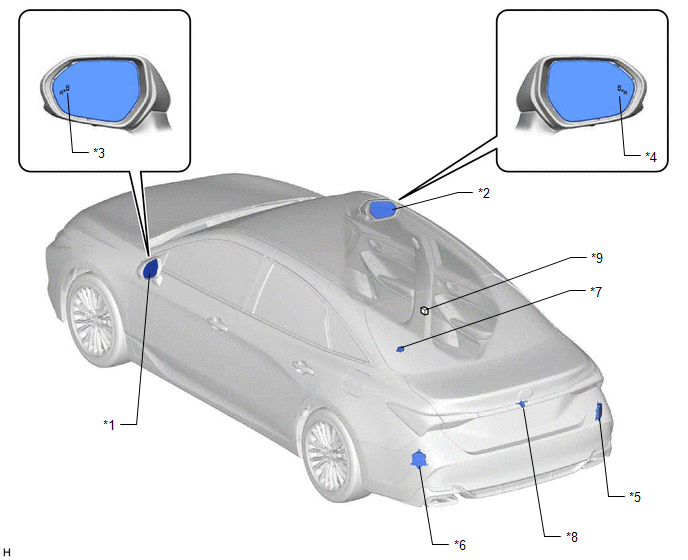
|
*1 | OUTER MIRROR LH |
*2 | OUTER MIRROR RH |
|
*3 | OUTER REAR VIEW MIRROR INDICATOR LH |
*4 | OUTER REAR VIEW MIRROR INDICATOR RH |
|
*5 | BLIND SPOT MONITOR SENSOR RH (MASTER) |
*6 | BLIND SPOT MONITOR SENSOR LH (SLAVE) |
|
*7 | RCTA BUZZER (BLIND SPOT MONITOR BUZZER) |
*8 | TELEVISION CAMERA ASSEMBLY (w/ Parking Assist Monitor System) |
|
*9 | NO. 26 JUNCTION CONNECTOR |
- | - |
ILLUSTRATION
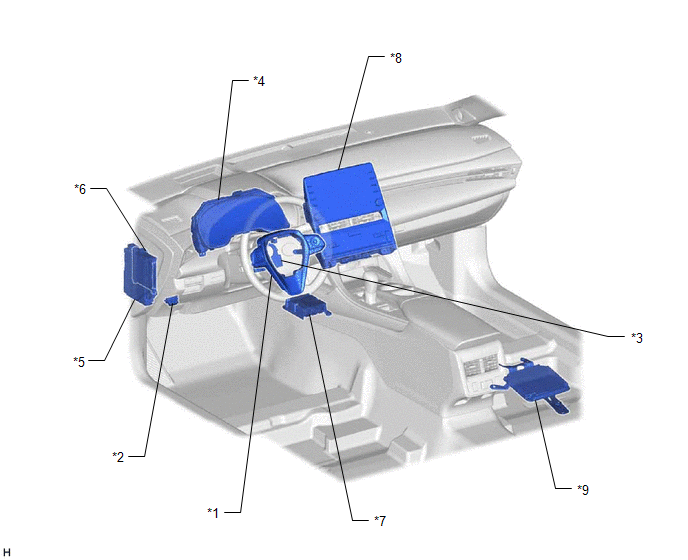
|
*1 | STEERING PAD SWITCH ASSEMBLY |
*2 | DLC3 |
|
*3 | STEERING SENSOR |
*4 | COMBINATION METER ASSEMBLY
- MULTI-INFORMATION DISPLAY |
|
*5 | INSTRUMENT PANEL JUNCTION BLOCK ASSEMBLY
- ECU-IG1 NO. 4 FUSE - IG1-NO. 1 RELAY |
*6 | MAIN BODY ECU (MULTIPLEX NETWORK BODY ECU) |
|
*7 | AIRBAG SENSOR ASSEMBLY - YAW RATE AND ACCELERATION SENSOR |
*8 | RADIO AND DISPLAY RECEIVER ASSEMBLY
- MULTI-DISPLAY |
|
*9 | PARKING ASSIST ECU (w/ Panoramic View Monitor System) |
- | - |
Power Source Circuit
DESCRIPTION
This circuit provides power to operate the blind spot monitor sensor.
WIRING DIAGRAM
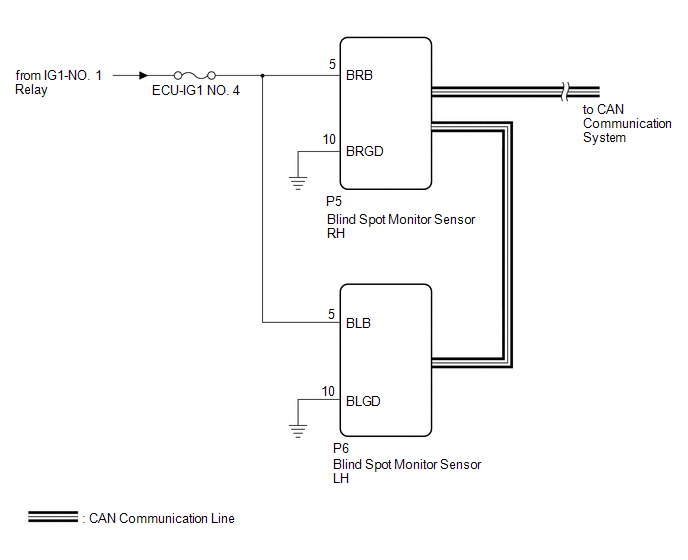
CAUTION / NOTICE / HINT
NOTICE:
Inspect the fuses for circuits related to this system before performing the following procedure.
PROCEDURE
| 1. |
CHECK HARNESS AND CONNECTOR (BLIND SPOT MONITOR SENSOR RH POWER SOURCE) |
(a) Disconnect the P5 blind spot monitor sensor RH connector.
(b) Measure the voltage according to the value(s) in the table below.
Standard Voltage:
|
Tester Connection | Condition |
Specified Condition |
|
P5-5 (BRB) - Body ground |
Engine switch on (IG) |
11 to 14 V |
|
P5-5 (BRB) - Body ground |
Engine switch off | Below 1 V |
| NG |
 | REPAIR OR REPLACE HARNESS OR CONNECTOR |
|
OK |
 | |
| 2. |
CHECK HARNESS AND CONNECTOR (BLIND SPOT MONITOR SENSOR RH - BODY GROUND) |
(a) Measure the resistance according to the value(s) in the table below.
Standard Resistance:
|
Tester Connection | Condition |
Specified Condition |
|
P5-10 (BRGD) - Body ground |
Always | Below 1 Ω |
| NG |
 | REPAIR OR REPLACE HARNESS OR CONNECTOR |
|
OK |
 | |
| 3. |
CHECK HARNESS AND CONNECTOR (BLIND SPOT MONITOR SENSOR LH POWER SOURCE) |
(a) Disconnect the P6 blind spot monitor sensor LH connector.
(b) Measure the voltage according to the value(s) in the table below.
Standard Voltage:
|
Tester Connection | Condition |
Specified Condition |
|
P6-5 (BLB) - Body ground |
Engine switch on (IG) |
11 to 14 V |
|
P6-5 (BLB) - Body ground |
Engine switch off | Below 1 V |
| NG |
 | REPAIR OR REPLACE HARNESS OR CONNECTOR |
|
OK |
 | |
| 4. |
CHECK HARNESS AND CONNECTOR (BLIND SPOT MONITOR SENSOR LH - BODY GROUND) |
(a) Measure the resistance according to the value(s) in the table below.
Standard Resistance:
|
Tester Connection | Condition |
Specified Condition |
|
P6-10 (BLGD) - Body ground |
Always | Below 1 Ω |
| OK |
 | PROCEED TO NEXT SUSPECTED AREA SHOWN IN PROBLEM SYMPTOMS TABLE |
| NG |
 | REPAIR OR REPLACE HARNESS OR CONNECTOR |
Precaution
PRECAUTION
PRECAUTION FOR DISCONNECTING CABLE FROM NEGATIVE BATTERY TERMINAL
NOTICE:
When
disconnecting the cable from the negative (-) battery terminal,
initialize the following systems after the cable is reconnected.
|
System Name | See Procedure |
|
Lane Departure Alert System (w/ Steering Control) |
 |
|
Intelligent Clearance Sonar System |
|
Parking Assist Monitor System |
|
Panoramic View Monitor System |
|
Pre-collision System |
| Lighting System (for Gasoline Model with Cornering Light) |
PRECAUTIONS FOR BLIND SPOT MONITOR SYSTEM
(a) The blind spot monitor function may not detect vehicles correctly in the following conditions:
(1) When the sensor is misaligned due to a strong impact to the sensor or its surrounding area.
(2) When mud, snow, ice, a sticker, etc. is covering the sensor or its surrounding area on the rear bumper.
(3)
When driving on a road surface that is wet with standing water or there
is snow during bad weather such as heavy rain, snow, or fog.
(4) When multiple vehicles are approaching with only a small gap between each vehicle.
(5) When the distance between this vehicle and a following vehicle is short.
(6) When there is a significant difference in speed between this vehicle and the vehicle that enters the detection area.
(7) When the difference in speed between this vehicle and another vehicle is changing.
(8) When a vehicle enters a detection area traveling at about the same speed as this vehicle.
(9) As this vehicle starts from a stop, a vehicle remains in the detection area.
(10) When driving up and down consecutive steep inclines, such as hills, dips in the road, etc.
(11) When driving on roads with sharp bends, consecutive curves, or uneven surfaces.
(12)
When vehicle lanes are wide, or when driving on the edge of a lane, and
the vehicle in an adjacent lane is far away from this vehicle.
(13) When towing a trailer.
(14) When a bicycle carrier or other accessory is installed to the rear of the vehicle.
(15) When there is a significant difference in height between this vehicle and the vehicle that enters the detection area.
(16) Immediately after the blind spot monitor system is turned on.
HINT:
In this section, the expression "this vehicle" is used to refer to the vehicle equipped with this blind spot monitor system.
(b) The blind spot monitor function is not designed to detect the following types of vehicles or objects:
(1) Vehicles traveling from the opposite direction.
(2) Small motorcycles, bicycles, pedestrians, etc.*
(3) Following vehicles that are in the same lane.*
(4) Guardrails, walls, signs, parked vehicles and similar stationary objects.*
(5) Vehicles driving 2 lanes across from this vehicle.
- *: Depending on conditions, detection of a vehicle and/or object may occur.
(c) Instances of the blind spot
monitor function unnecessarily detecting a vehicle and/or object may
increase under the following conditions:
(1) When the sensor is misaligned due to a strong impact to the sensor or its surrounding area.
(2) When a distance between this vehicle and a guardrail, wall, etc. that enters the detection area is short.
(3) When driving up and down consecutive steep inclines, such as hills, dips in the road, etc.
(4)
When vehicle lanes are narrow, or when driving on the edge of a lane,
and a vehicle traveling in a lane other than the adjacent lanes enters
the detection area.
(5) When driving on roads with sharp bends, consecutive curves, or uneven surfaces.
(6) When the tires are slipping or spinning.
(7) When the distance between this vehicle and a following vehicle is short.
(8) When a bicycle carrier or other accessory is installed to the rear of the vehicle.
(9) When towing a trailer.
(d) The RCTA function may not detect vehicles correctly in the following conditions:
(1) When the sensor is misaligned due to a strong impact to the sensor or its surrounding area.
(2) When mud, snow, ice,a sticker, etc. is covering the sensor or surrounding area on the rear bumper.
(3) When driving on a road surface that is wet with standing water during bad weather such as heavy rain, snow, or fog.
(4) When multiple vehicles are approaching with only a small gap between each vehicle.
(5) When a vehicle is approaching at high speed.
(6) When towing a trailer.
(7) When backing up on a slope with a sharp change in grade.
(8) When backing out of a shallow angle parking spot.
(9) Directly after the RCTA function is turned on
(10) Directly after the engine is started with the RCTA function is turned on
(11) When the sensors cannot detect a vehicle due to obstructions.
(e) The RCTA function is not designed to detect the following types of vehicles or objects:
(1) Vehicles approaching from directly behind.
(2) Vehicles backing up in a parking space next to this vehicle.
(3) Vehicles that the sensors cannot detect due to obstructions.
(4) Guardrails, walls, signs, parked vehicles and similar stationary objects.*
(5) Small motorcycles, bicycles, pedestrians, etc.*
(6) Vehicles moving away from this vehicle.
(7) Vehicles approaching from the parking spaces next to this vehicle.*
HINT:
In this section, the expression "this vehicle" is used to refer to the vehicle equipped with this blind spot monitor system.
- *: Depending on conditions, detection of a vehicle and/or object may occur.
(f) Instances of the RCTA function unnecessarily detecting a vehicle and/or object may increase under the following condition:
(1) When a vehicle passes by the side of this vehicle.
(2) When the parking space faces a street and vehicles are being driven on the street.
(3)
When the distance between this vehicle and metal objects, such as a
guardrail, wall, sign, or parked vehicle, which may reflect electrical
waves toward the rear of the vehicle, is short
HINT:
In this section, the expression "this vehicle" is used to refer to the vehicle equipped with this blind spot monitor system.
(g) Under the following conditions, the blind spot monitor system may store DTCs C1AC1 and C1AC2 by mistake:
(1)
The vehicle is driven continuously with the blind spot monitor system
on when using a drum tester such as a speedometer tester, brake/
speedometer combination tester or chassis dynamometer.
(2) When mud, snow, ice, a sticker, etc. is covering the sensor or surrounding area on the rear bumper.
HANDLING THE RADAR SENSOR
(a)
Blind spot monitor sensors are installed behind the left and right
sides of the rear bumper respectively. Observe the following to ensure
the blind spot monitor can function correctly.
(1) Keep the sensors and the surrounding areas on the rear bumper clean at all times.
(2)
Do not subject a sensor or its surrounding area on the rear bumper to a
strong impact. If a sensor is moved even slightly off position, the
system may malfunction and vehicles may not be detected correctly. In
the following situations, inspect the sensor and surrounding area.
- A sensor or its surrounding area is subjected to a strong impact.
- If the surrounding area of a sensor is scratched or dented, or part of them has become disconnected.
(3) Do not disassemble the sensor.
(4) Do not attach stickers to the sensor or surrounding area on the rear bumper.
(5) Do not modify the sensor or surrounding area on the rear bumper.
(6) Do not paint the rear bumper any color other than an official Toyota color.
(7) Do not drop a sensor or subject it to a strong impact, as it is a high-precision device.
(8) Do not reuse a sensor that has been dropped or subjected to a strong impact.
Problem Symptoms Table
PROBLEM SYMPTOMS TABLE
HINT:
- Use the table below to help determine the cause of problem symptoms. If
multiple suspected areas are listed, the potential causes of the
symptoms are listed in order of probability in the "Suspected Area"
column of the table. Check each symptom by checking the suspected areas
in the order they are listed. Replace parts as necessary.
- Inspect the fuses and relays related to this system before inspecting the suspected areas below.
Entire System |
Symptom | Suspected Area |
Link |
|
System does not operate at all |
Proceed to "Power Source Circuit" |
 |
|
CAN communication system |
 |
|
Blind spot monitor sensor RH |
 |
|
System cannot be turned off |
CAN communication system |
 |
|
Blind spot monitor sensor RH |
 |
|
"Blind
Spot Monitor Unavailable" or "Blind Spot Monitor System Malfunction
Visit Your Dealer" is displayed on the multi-information display |
Check abnormality history |
 |
|
Blind spot monitor sensor RH |
 |
|
Blind spot monitor sensor LH |
 |
|
Combination meter assembly |
 |
|
"Rear
Cross Traffic Alert Unavailable" or "Rear Cross Traffic Alert
Malfunction Visit Your Dealer" is displayed on the multi-information
display | Check abnormality history |
 |
|
Blind spot monitor sensor RH |
 |
|
Blind spot monitor sensor LH |
 |
|
Combination meter assembly |
 |
Blind Spot Monitor Function |
Symptom | Suspected Area |
Link |
|
Outer rear view mirror indicator RH does not illuminate |
Proceed to "Blind Spot Monitor Beam Axis Confirmation" |
 |
|
Outer mirror RH |
 |
|
Outer mirror control ECU assembly RH*3 |
 |
|
Outer rear view mirror assembly RH |
 |
|
Blind spot monitor sensor RH |
 |
|
Outer rear view mirror indicator LH does not illuminate |
Proceed to "Blind Spot Monitor Beam Axis Confirmation" |
 |
|
Outer mirror LH |
 |
|
Outer mirror control ECU assembly LH*3 |
 |
|
Outer rear view mirror assembly LH |
 |
|
Blind spot monitor sensor LH |
 |
|
Outer rear view mirror indicator RH remains illuminated |
Proceed to "Blind Spot Monitor Beam Axis Confirmation" |
 |
|
Blind spot monitor sensor RH |
 |
|
Outer rear view mirror indicator LH remains illuminated |
Proceed to "Blind Spot Monitor Beam Axis Confirmation" |
 |
|
Blind spot monitor sensor LH |
 |
|
Outer rear view mirror indicator RH does not flash |
Proceed to "Turn Signal Light" in Problem Symptoms Table for the Lighting (EXT) section*4 |
 |
|
Proceed to "Turn Signal Light" in Problem Symptoms Table for the Lighting (EXT) section*5 |
 |
|
Blind spot monitor sensor RH |
 |
|
Outer rear view mirror indicator LH does not flash |
Proceed to "Turn Signal Light" in Problem Symptoms Table for the Lighting (EXT) section*4 |
 |
|
Proceed to "Turn Signal Light" in Problem Symptoms Table for the Lighting (EXT) section*5 |
 |
|
Blind spot monitor sensor LH |
 |
|
Outer rear view mirror indicator RH continues to flash |
Blind spot monitor sensor RH |
 |
|
Outer rear view mirror indicator LH continues to flash |
Blind spot monitor sensor LH |
 |
RCTA Function |
Symptom | Suspected Area |
Link |
|
Function does not operate at all (Blind spot monitor function operates normally) |
Data list / active test (Reverse) |
 |
|
Automatic transmission system |
 |
|
Blind spot monitor sensor LH |
 |
|
While RCTA function is active, outer rear view mirror indicator flashes but RCTA buzzer does not sound. |
Proceed to "Buzzer does not Sound" |
 |
|
When shift lever is in R, detection operation is normal but RCTA indicator does not appear on multi-display |
CAN communication system |
 |
|
Blind spot monitor sensor RH |
 |
|
Blind spot monitor sensor LH |
 |
|
Radio and display receiver assembly |
 |
|
Television camera assembly*1 |
 |
|
Parking assist ECU*2 |
 |
- *1: w/ Parking Assist Monitor System
- *2: w/ Panoramic View Monitor System
- *3: w/ Seat Memory
- *4: for HV Model with Cornering Light
- *5: for HV Model without Cornering Light
System Description
SYSTEM DESCRIPTION
GENERAL
(a) The blind spot monitor system has a blind spot monitor function and RCTA function.
(1) Blind spot monitor function
- The blind spot monitor function is a function that assists the driver when changing lanes.
This function uses quasi-millimeter wave radar to
detect vehicles that are traveling in adjacent lanes in the areas that
are not visible using the outer rear view mirror assemblies (blind
spots) and vehicles that are approaching rapidly from up to 60 m behind
this vehicle in the areas that are not visible using the outer rear view
mirror assemblies (blind spots).
The function
advises the driver of the existence of a vehicle by illuminating the
outer rear view mirror indicator on the outer rear view mirror assembly.
- If the turn signal switch is operated while the outer rear view mirror
indicator on an outer rear view mirror assembly is illuminated, the
indicator starts blinking to give additional warning to the driver.
(2) RCTA function
- The RCTA function is a function that informs the driver a vehicle is
approaching from the left or the right at the rear of the vehicle. The
function uses quasi-millimeter wave radar to detect the position and
relative speed of other vehicles. When the function determines that a
vehicle is approaching this vehicle, this function informs the driver
using the outer rear view mirror indicators and blind spot monitor
buzzer.
FUNCTION OF COMPONENTS
|
Component | Function |
|
Blind Spot Monitor Sensor |
- Consists of a 24 GHz radar module and an integrated processing module.
- Illuminates or blinks the outer rear view mirror indicator on an outer rear view mirror assembly with cover.
- Sounds the RCTA buzzer (blind spot monitor buzzer) when the RCTA function is operating.
- Changes the outer rear view mirror indicator on an outer rear view
mirror assembly with cover from illuminated to blinking when a turn
signal switch operation signal is received from the combination meter
assembly with the blind spot monitor system operating.
- Dims the outer rear view mirror indicator on the outer rear view mirror assembly with cover.
- Displays the RCTA icon on the multi-display when the RCTA function is operating.
|
| Outer Rear View Mirror Assembly With Cover
- Outer Mirror (Outer Rear View Mirror Indicator)
| Turns on or blinks the indicator based on a signal from the blind spot monitor sensor. |
|
Steering Pad Switch Assembly | Enables,
disables or cuts off the operation of the blind spot monitor system by
transmitting switch operation signals to the combination meter assembly. |
|
RCTA Buzzer (Blind Spot Monitor Buzzer) |
Sounds based on a signal from the blind spot monitor sensor. |
|
Combination Meter Assembly
- Multi-information Display
|
- Transmits a turn signal switch operation signal from the headlight
dimmer switch assembly to the blind spot monitor sensor via CAN
communication.
- Displays an error message on the multi-information display if the blind
spot monitor sensor detects a malfunction while it is operating.
|
| Main Body ECU (Multiplex Network Body ECU) |
Transmits the destination information and the dimmer signal to the blind spot monitor sensors via CAN communication. |
|
Skid Control ECU | Transmits a vehicle speed signal to the blind spot monitor sensors via CAN communication. |
|
ECM | Transmits a shift position signal (R) to the blind spot monitor sensors via CAN communication. |
|
Steering Sensor | Detects
the angle of the steering wheel and transmits the resulting signals to
the blind spot monitor sensors via CAN communication. |
|
Airbag Sensor Assembly
- Yaw Rate and Acceleration Sensor
| Transmits the yaw rate signal to the blind spot monitor sensor via CAN communication. |
- Television Camera Assembly*1
- Parking Assist ECU*2
| Receives
the blind spot monitor sensor information via CAN communication and
sends it to the multi-display through the video signal cable. |
|
Radio and Display Receiver Assembly |
- Receives the video signals from the television camera assembly and displays the RCTA icon on the display panel.*1
- Receives the video signals from the parking assist ECU and displays the RCTA icon on the display panel.*2
|
- *1: w/ Parking Assist Monitor System
- *2: w/ Panoramic View Monitor System
OPERATION DESCRIPTION
(a) Operation description of the blind spot monitor system
(1) Operation conditions:
- The blind spot monitor system is on.
- The shift lever is in any position other than R.
- Vehicle speed is more than approximately 16 km/h (10 mph).
(2) Conditions in which a sensor can detect a vehicle
The blind spot monitor system indicates detection of a vehicle in the detection area when either condition is met:
- When a vehicle is detected in an adjacent lane overtaking this vehicle.
- When a vehicle is detected entering the detection area because it changed lanes.
(3) Detection area
Vehicles in the following areas can be detected:
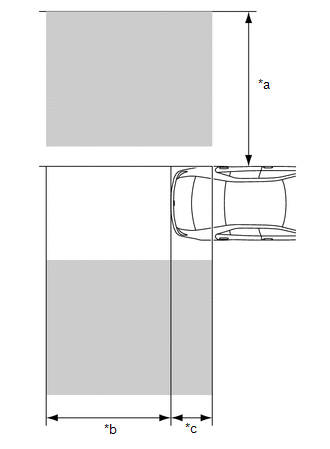
|
*a | Within Approx. 3.5 m (11.48 ft) from Side of Vehicle |
|
*b | Within Approx. 3 m (9.84 ft) behind Rear Bumper |
|
*c | Within Approx. 1 m (3.28 ft) forward of Rear Bumper |
 |
Detection Area |
(b) Operation description of the RCTA function
(1) Operation conditions:
- The RCTA function is on.
- The shift lever is in R.
- The vehicle speed is less than approximately 8 km/h (5 mph).
(2) Conditions in which a sensor can detect a vehicle
The RCTA function indicates detection of a vehicle in the detection area when both conditions are met:
- A vehicle is approaching from the right or left at the rear of the vehicle.
- The vehicle speed is approximately 8 km/h (5 mph) to 28 km/h (18 mph).
(3) Detection area
Vehicles in the following areas can be detected:
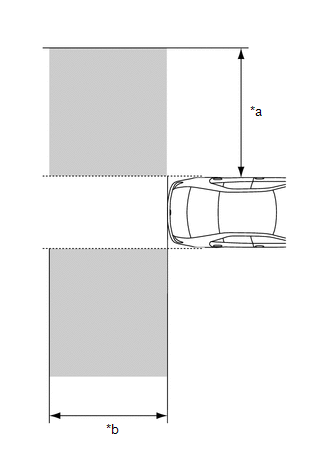
|
*a | Within Approx. 5.5 to 20 m (18.05 to 65.62 ft) from Side of Vehicle (detection area changes according to vehicle speed) |
|
*b | Within Approx. 6 m (19.69 ft) behind Rear Bumper |
 |
Detection Area |
OPERATION OF OUTER REAR VIEW MIRROR INDICATOR AND RCTA BUZZER (BLIND SPOT MONITOR BUZZER)
(a) Initial check
(1)
When the blind spot monitor system is turned on with the engine switch
on (IG), the outer rear view mirror indicators on the outer rear view
mirror assembly with cover illuminate for 3 seconds.
(2)
When the RCTA function is turned on with the engine switch on (IG), the
outer rear view mirror indicators on the outer rear view mirror
assembly with cover illuminate for 3 seconds and the RCTA buzzer (blind
spot monitor buzzer) sounds for 1 second.
(3) When
the engine switch is turned from off to ON with the blind spot monitor
system on, the outer rear view mirror indicators on the outer rear view
mirror assembly with cover illuminate for 3 seconds.
(b) Operation for each function
(1) Operation for blind spot monitor system
- When a sensor detects a vehicle in the blind spot area, the outer rear
view mirror indicator on the outer rear view mirror assembly with cover
illuminates.
- If the turn signal switch is operated while the sensor is detecting a
vehicle in the detection area and the outer rear view mirror indicator
on the outer rear view mirror assembly with cover is illuminated, the
indicator starts blinking as shown in the illustration.
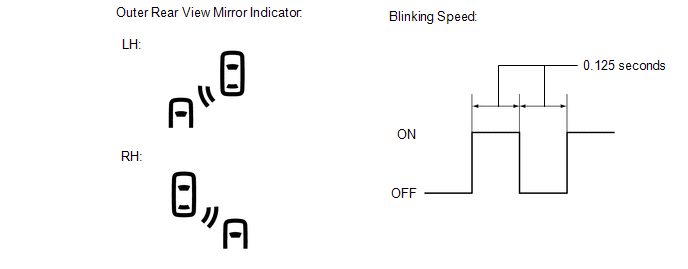
(2) Operation for RCTA function
- When all of the operation conditions for the RCTA function are met, the
outer rear view mirror indicators on the outer rear view mirror assembly
with cover blink for 2.5 seconds and the RCTA buzzer (blind spot
monitor buzzer) sounds for 2.3 seconds as shown in the illustration.
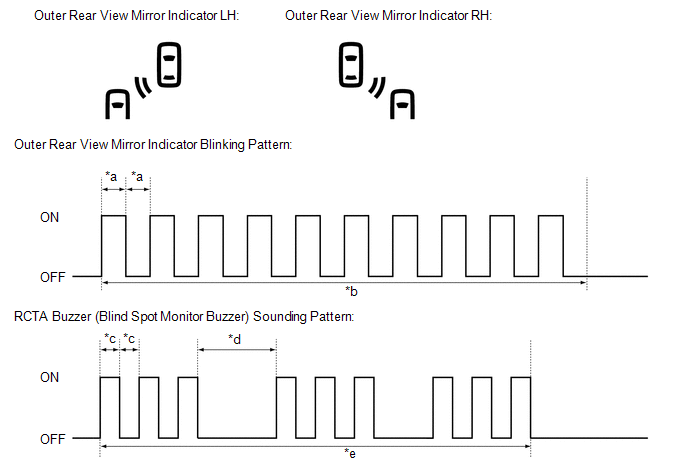
|
*a | 0.125 Seconds |
*b | 2.5 Seconds |
|
*c | 0.1 Seconds |
*d | 0.4 Seconds |
|
*e | 2.3 Seconds |
- | - |
RCTA ICON OUTLINE
(a)
If a vehicle approaching from the right or left at the rear of the
vehicle is detected, the icon will illuminate on the multi-display.
w/ Parking Assist Monitor System
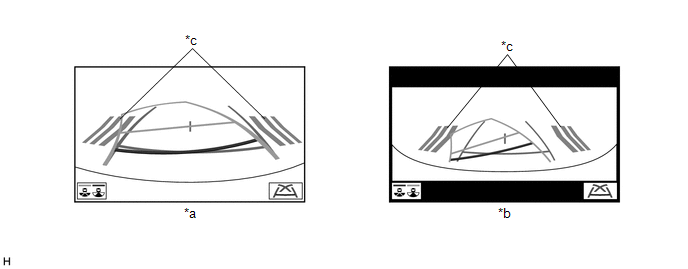
|
*a | Narrow rear view screen |
*b | Wide Rear View Screen |
|
*c | RCTA Icon |
- | - |
w/ Panoramic View Monitor System
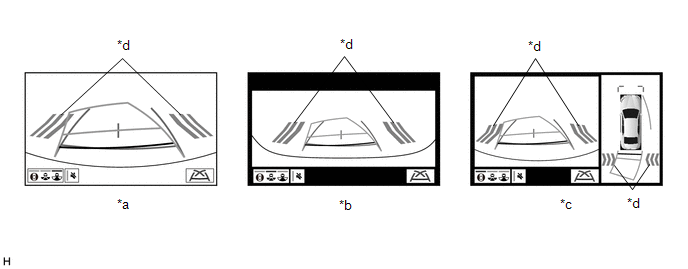
|
*a | Narrow rear view screen |
*b | Wide Rear View Screen |
|
*c | Panoramic view and rear view screen |
*d | RCTA Icon |
Terminals Of Ecu
TERMINALS OF ECU
BLIND SPOT MONITOR SENSOR RH (MASTER)

|
Terminal No. (Symbol) |
Wiring Color | Terminal Description |
Condition | Specified Condition |
|
P5-4 (OMIR) - P5-10 (BRGD) |
R - W-B | Outer rear view mirror indicator RH power source |
Outer rear view mirror indicator RH illuminated |
3.5 to 9.5 V |
| Outer rear view mirror indicator RH blinking |
Alternating between 0 to 9.5 V |
|
Outer rear view mirror indicator RH not illuminated |
Below 1 V |
| P5-5 (BRB) - P5-10 (BRGD) |
B - W-B | IG power source |
Engine switch off | Below 1 V |
|
Engine switch on (IG) |
11 to 14 V |
| P5-10 (BRGD) - Body Ground |
W-B - Body ground | Ground |
Always | Below 1 V |
BLIND SPOT MONITOR SENSOR LH (SLAVE)

|
Terminal No. (Symbol) |
Wiring Color | Terminal Description |
Condition | Specified Condition |
|
P6-3 (BUZ) - P6-10 (BLGD) |
W - W-B | RCTA buzzer (blind spot monitor buzzer) operation signal |
RCTA buzzer (blind spot monitor buzzer) not sounding |
11 to 14 V |
| RCTA buzzer (blind spot monitor buzzer) sounding |
Alternating between 0 to 14 V |
|
P6-4 (OMIL) - P6-10 (BLGD) |
R - W-B | Outer rear view mirror indicator LH power source |
Outer rear view mirror indicator LH illuminated |
3.5 to 9.5 V |
| Outer rear view mirror indicator LH blinking |
Alternating between 0 to 9.5 V |
|
Outer rear view mirror indicator LH not illuminated |
Below 1 V |
| P6-5 (BLB) - P6-10 (BLGD) |
B - W-B | IG power source |
Engine switch off | Below 1 V |
|
Engine switch on (IG) |
11 to 14 V |
| P6-10 (BLGD) - Body Ground |
W-B - Body ground | Ground |
Always | Below 1 V |
Lost Communication with ECM / PCM "A" (U0100,U0125,U0126,U0129,U0142)
DESCRIPTION
These DTCs are stored if there is a malfunction in the CAN communication system connected to the blind spot monitor sensor.
HINT:
If CAN communication system DTCs are stored, they may also be stored for other systems.
Blind Spot Monitor Master |
DTC No. | Detection Item |
DTC Detection Condition | Trouble Area |
|
U0100 | Lost Communication with ECM / PCM "A" |
Lost communication with ECM |
CAN communication system |
|
U0125 | Lost Communication with Yaw Rate Sensor Module |
Lost communication with airbag sensor assembly |
CAN communication system |
|
U0126 | Lost Communication with Steering Angle Sensor Module |
Lost communication with steering sensor |
CAN communication system |
|
U0129 | Lost Communication with Brake System Control Module |
Lost communication with brake system |
CAN communication system |
|
U0142 | Lost Communication with Body Control Module "B" |
Lost communication with main body ECU |
CAN communication system |
Blind Spot Monitor Slave |
DTC No. | Detection Item |
DTC Detection Condition | Trouble Area |
|
U0100 | Lost Communication with ECM / PCM "A" |
Lost communication with ECM |
CAN communication system |
|
U0125 | Lost Communication with Yaw Rate Sensor Module |
Lost communication with airbag sensor assembly |
CAN communication system |
|
U0126 | Lost Communication with Steering Angle Sensor Module |
Lost communication with steering sensor |
CAN communication system |
|
U0129 | Lost Communication with Brake System Control Module |
Lost communication with brake system |
CAN communication system |
|
U0142 | Lost Communication with Body Control Module "B" |
Lost communication with main body ECU |
CAN communication system |
CAUTION / NOTICE / HINT
NOTICE:
When checking for DTCs, make sure that the blind spot monitor system is turned on.
PROCEDURE
(a) Turn the engine switch off.
(b) Turn the engine switch on (IG).
(c) Recheck for DTCs and check if the same DTC is output again.
Body Electrical > Blind Spot Monitor Master > Trouble Codes Body
Electrical > Blind Spot Monitor Slave > Trouble Codes
|
Result | Proceed to |
|
Blind Spot Monitor Master DTCs including DTC U0232 are output. |
A |
| Blind Spot Monitor Master DTCs other than DTC U0232 are output. |
B |
| No DTCs are output |
C |
HINT:
- If CAN communication system DTCs are stored, they may also be stored for other systems.
- If the CAN communication system has been inspected and repaired, the DTCs will not be output when rechecking for DTCs.
- If these DTCs are output frequently, duplicate the conditions that cause
the problem symptoms and perform troubleshooting again, even though the
DTC was not output when rechecking for DTCs.
Click here 
| A |
 | GO TO DTC U0232 |
| B |
 | GO TO CAN COMMUNICATION SYSTEM |
| C |
 | USE SIMULATION METHOD TO CHECK |
Lost Communication with Blind Spot Monitor Slave Module (U0232)
DESCRIPTION
This DTC is
stored when the blind spot monitor sensor RH judges that there is a
communication problem with the blind spot monitor sensor LH.
|
DTC No. | Detection Item |
DTC Detection Condition | Trouble Area |
|
U0232 | Lost Communication with Blind Spot Monitor Slave Module |
The blind spot monitor sensor (master) cannot receive signals from the blind spot monitor sensor (slave) |
- Open or short in CAN bus main wire or connector
- Open or short in NO. 26 junction connector
- Blind spot monitor sensor LH
- Power source circuit of blind spot monitor sensor LH
- Blind spot monitor sensor LH ground circuit
- Blind spot monitor sensor RH
- Wire harness or connector
|
WIRING DIAGRAM
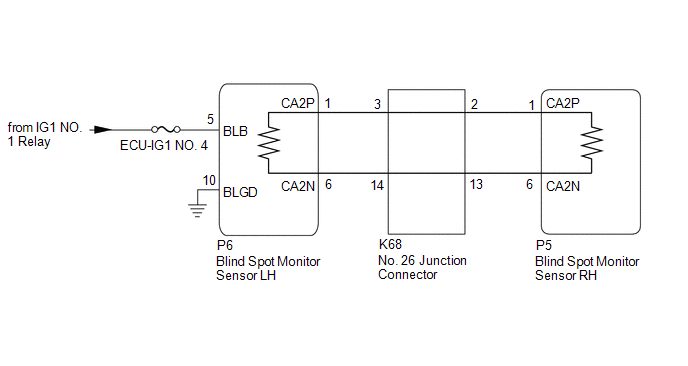
CAUTION / NOTICE / HINT
NOTICE:
- When checking for DTCs, make sure that the blind spot monitor system is turned on.
- Inspect the fuses for circuits related to this system before performing the following procedure.
- Before measuring the resistance of the CAN bus, turn the engine switch
off and leave the vehicle for 1 minute or more without operating the key
or any switches, or opening or closing the doors. After that,
disconnect the cable from the negative (-) battery terminal and leave
the vehicle for 1 minute or more before measuring the resistance.
- After turning the engine switch off, waiting time may be required before
disconnecting the cable from the negative (-) battery terminal.
Therefore, make sure to read the disconnecting the cable from the
negative (-) battery terminal notices before proceeding with work.
Click here 
HINT:
- Operating the engine switch, any other switches or a door triggers
related ECU and sensor communication on the CAN. This communication will
cause the resistance value to change.
- Even after DTCs are cleared, if a DTC is stored again after driving the
vehicle for a while, the malfunction may be occurring due to vibration
of the vehicle. In such a case, wiggling the ECUs or wire harness while
performing the inspection below may help determine the cause of the
malfunction.
PROCEDURE
|
1. | CHECK CAN BUS MAIN WIRE |
(a) Turn the engine switch off.
(b) Disconnect the cable from the negative (-) battery terminal.
| (c) Measure the resistance according to the value(s) in the table below.
Standard Resistance: |
Tester Connection | Condition |
Specified Condition | Result | |
P5-1 (CA2P) - P5-6 (CA2N) |
Cable disconnected from negative (-) battery terminal |
54 to 69 Ω | Below 54 Ω: Short circuit between bus lines | |
70 Ω or more: Open circuit in main bus lines | |
P5-1 (CA2P) - G45-4 (CG) |
Cable disconnected from negative (-) battery terminal |
200 Ω or higher | Below 200 Ω: CA2P short to ground | |
P5-6 (CA2N) - G45-4 (CG) |
Cable disconnected from negative (-) battery terminal |
200 Ω or higher | Below 200 Ω: CA2N short to ground | |
P5-1 (CA2P) - G45-16 (BAT) |
Cable disconnected from negative (-) battery terminal |
6 kΩ or higher | Below 6 kΩ: CA2P +B short | |
P5-6 (CA2N) - G45-16 (BAT) |
Cable disconnected from negative (-) battery terminal |
6 kΩ or higher | Below 6 kΩ: CA2N +B short | |
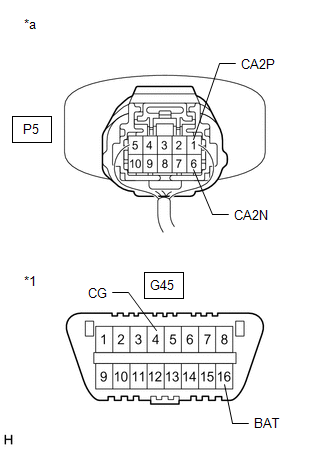 |
|
*1 | DLC3 | |
*a | Component with harness connected
(Blind Spot Monitor Sensor RH) | | |
(d) Reconnect the cable to the negative (-) battery terminal.
|
Result | Proceed to |
|
OK | A |
|
Open circuit in CAN main bus lines |
B |
| Short circuit between bus lines |
C |
|
| D |
| B |
 | GO TO STEP 5 |
| C |
 | GO TO STEP 8 |
| D |
 | GO TO STEP 11 |
|
A |
 | |
| 2. |
CHECK HARNESS AND CONNECTOR (BLIND SPOT MONITOR SENSOR LH - BODY GROUND) |
Click here 
| NG |
 | REPAIR OR REPLACE HARNESS OR CONNECTOR |
|
OK |
 | |
| 3. |
CHECK HARNESS AND CONNECTOR (BLIND SPOT MONITOR SENSOR LH - POWER SOURCE) |
Click here 
| NG |
 | REPAIR OR REPLACE HARNESS OR CONNECTOR |
|
OK |
 | |
(a) Turn the engine switch off.
(b) Turn the engine switch on (IG).
(c) Check for DTCs.
Body Electrical > Blind Spot Monitor Master > Trouble Codes
OK:
No DTCs are output.
| OK |  |
SYMPTOM SIMULATION |
| NG |
 | REPLACE BLIND SPOT MONITOR SENSOR LH |
| 5. |
CHECK FOR OPEN IN CAN BUS MAIN WIRE (NO. 26 JUNCTION CONNECTOR) |
| (a) Disconnect the K68 No. 26 junction connector. |
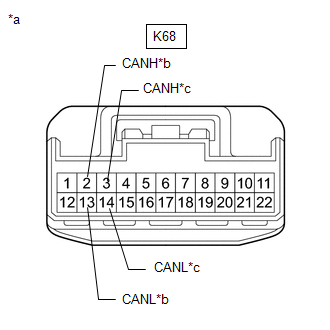 |
|
*a | Front view of wire harness connector
(to No. 26 Junction Connector) | |
*b | to Blind Spot Monitor Sensor RH CAN main wire | |
*c | to Blind Spot Monitor Sensor LH CAN main wire | | |
(b) Measure the resistance according to the value(s) in the table below.
Standard Resistance:
|
Tester Connection | Condition |
Specified Condition |
|
K68-3 (CANH) - K68-14(CANL) |
Cable disconnected from negative (-) battery terminal |
108 to 132 Ω |
|
K68-2 (CANH) - K68-13(CANL) |
Cable disconnected from negative (-) battery terminal |
108 to 132 Ω |
|
Result | Proceed to |
|
OK | A |
|
NG (to blind spot monitor sensor RH CAN main wire) |
B |
| NG (to blind spot monitor sensor LH CAN main wire) |
C |
| A |
 | REPLACE NO. 26 JUNCTION CONNECTOR |
| C |
 | GO TO STEP 7 |
|
B |
 | |
| 6. |
CHECK FOR OPEN IN CAN BUS MAIN WIRE (BLIND SPOT MONITOR SENSOR RH) |
(a) Reconnect the K68 No. 26 junction connector.
| (b) Disconnect the P5 blind spot monitor sensor RH connector. |
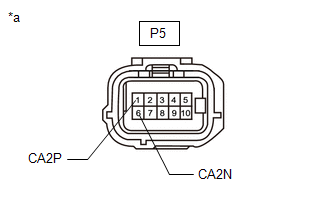 |
|
*a | Front view of wire harness connector
(to Blind Spot Monitor Sensor RH) | | |
(c) Measure the resistance according to the value(s) in the table below.
Standard Resistance:
|
Tester Connection | Condition |
Specified Condition |
|
P5-1 (CA2P) - P5-6 (CA2N) |
Cable disconnected from negative (-) battery terminal |
108 to 132 Ω |
| OK |
 | REPLACE BLIND SPOT MONITOR SENSOR RH |
| NG |
 | REPAIR OR REPLACE CAN MAIN WIRE OR CONNECTOR (BLIND SPOT MONITOR SENSOR RH - No. 26 JUNCTION CONNECTOR) |
| 7. |
CHECK FOR OPEN IN CAN BUS MAIN WIRE (BLIND SPOT MONITOR SENSOR LH) |
(a) Reconnect the K68 No. 26 junction connector.
| (b) Disconnect the P6 blind spot monitor sensor LH connector. |
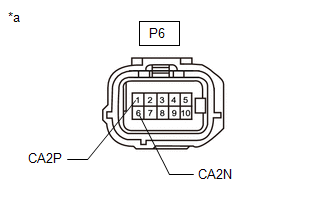 |
|
*a | Front view of wire harness connector
(to Blind Spot Monitor Sensor LH) | | |
(c) Measure the resistance according to the value(s) in the table below.
Standard Resistance:
|
Tester Connection | Condition |
Specified Condition |
|
P6-1 (CA2P) - P6-6 (CA2N) |
Cable disconnected from negative (-) battery terminal |
108 to 132 Ω |
| OK |
 | REPLACE BLIND SPOT MONITOR SENSOR LH |
| NG |
 | REPAIR OR REPLACE CAN MAIN WIRE OR CONNECTOR (BLIND SPOT MONITOR SENSOR LH - NO. 26 JUNCTION CONNECTOR) |
| 8. |
CHECK FOR SHORT IN CAN BUS WIRES (NO. 26 JUNCTION CONNECTOR) |
| (a) Disconnect the K68 No. 26 junction connector. |
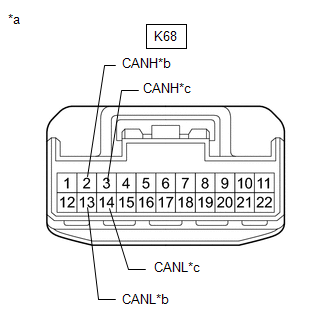 |
|
*a | Front view of wire harness connector
(to No. 26 Junction Connector) | |
*b | to Blind Spot Monitor Sensor RH CAN main wire | |
*c | to Blind Spot Monitor Sensor LH CAN main wire | | |
(b) Measure the resistance according to the value(s) in the table below.
Standard Resistance:
|
Tester Connection | Condition |
Specified Condition |
|
K68-3 (CANH) - K68-14 (CANL) |
Cable disconnected from negative (-) battery terminal |
108 to 132 Ω |
|
K68-2 (CANH) - K68-13 (CANL) |
Cable disconnected from negative (-) battery terminal |
108 to 132 Ω |
|
Result | Proceed to |
|
OK | A |
|
NG (to blind spot monitor sensor RH CAN main wire) |
B |
| NG (to blind spot monitor sensor LH CAN main wire) |
C |
| A |
 | REPLACE NO. 26 JUNCTION CONNECTOR |
| C |
 | GO TO STEP 10 |
|
B |
 | |
| 9. |
CHECK FOR SHORT IN CAN BUS WIRES (BLIND SPOT MONITOR SENSOR RH) |
(a) Reconnect the K68 No. 26 junction connector.
| (b) Disconnect the P5 blind spot monitor sensor RH connector. |
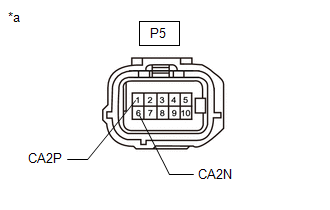 |
|
*a | Front view of wire harness connector
(to Blind Spot Monitor Sensor RH) | | |
(c) Measure the resistance according to the value(s) in the table below.
Standard Resistance:
|
Tester Connection | Condition |
Specified Condition |
|
P5-1 (CA2P) - P5-6 (CA2N) |
Cable disconnected from negative (-) battery terminal |
108 to 132 Ω |
| OK |
 | REPLACE BLIND SPOT MONITOR SENSOR RH |
| NG |
 | REPAIR OR REPLACE CAN MAIN WIRE OR CONNECTOR (BLIND SPOT MONITOR SENSOR RH - NO. 26 JUNCTION CONNECTOR) |
| 10. |
CHECK FOR SHORT IN CAN BUS WIRES (BLIND SPOT MONITOR SENSOR LH) |
(a) Reconnect the K68 No. 26 junction connector.
| (b) Disconnect the P6 blind spot monitor sensor LH connector. |
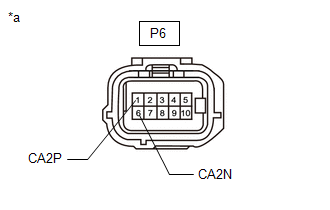 |
|
*a | Front view of wire harness connector
(to Blind Spot Monitor Sensor LH) | | |
(c) Measure the resistance according to the value(s) in the table below.
Standard Resistance:
|
Tester Connection | Condition |
Specified Condition |
|
P6-1 (CA2P) - P6-6 (CA2N) |
Cable disconnected from negative (-) battery terminal |
108 to 132 Ω |
| OK |
 | REPLACE BLIND SPOT MONITOR SENSOR LH |
| NG |
 | REPAIR OR REPLACE CAN MAIN WIRE OR CONNECTOR (BLIND SPOT MONITOR SENSOR LH - NO. 26 JUNCTION CONNECTOR) |
| 11. |
CHECK FOR SHORT IN CAN BUS WIRES (NO. 26 JUNCTION CONNECTOR) |
(a) Disconnect the K68 No. 26 junction connector.
(b) Measure the resistance according to the value(s) in the table below.
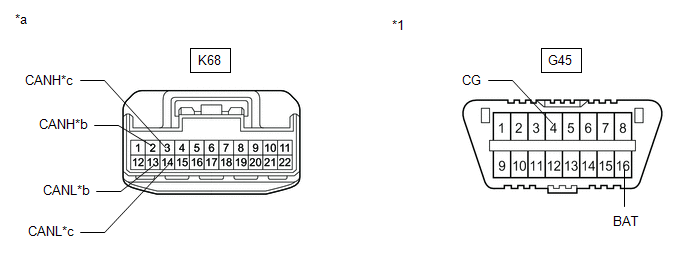
|
*1 | DLC3 |
- | - |
|
*a | Front view of wire harness connector
(to No. 26 Junction Connector) |
*b | to Blind Spot Monitor Sensor RH CAN main wire |
|
*c | to Blind Spot Monitor Sensor LH CAN main wire |
- | - |
Standard Resistance:
|
Tester Connection | Condition |
Specified Condition |
|
K68-3 (CANH) - G45-4 (CG) |
Cable disconnected from negative (-) battery terminal |
200 Ω or higher |
|
K68-14 (CANL) - G45-4 (CG) |
Cable disconnected from negative (-) battery terminal |
200 Ω or higher |
|
K68-3 (CANH) - G45-16 (BAT) |
Cable disconnected from negative (-) battery terminal |
6 kΩ or higher |
|
K68-14 (CANL) - G45-16 (BAT) |
Cable disconnected from negative (-) battery terminal |
6 kΩ or higher |
|
K68-2 (CANH) - G45-4 (CG) |
Cable disconnected from negative (-) battery terminal |
200 Ω or higher |
|
K68-13 (CANL) - G45-4 (CG) |
Cable disconnected from negative (-) battery terminal |
200 Ω or higher |
|
K68-2 (CANH) - G45-16 (BAT) |
Cable disconnected from negative (-) battery terminal |
6 kΩ or higher |
|
K68-13 (CANL) - G45-16 (BAT) |
Cable disconnected from negative (-) battery terminal |
6 kΩ or higher |
|
Result | Proceed to |
|
OK | A |
|
NG (to blind spot monitor sensor RH CAN main wire) |
B |
| NG (to blind spot monitor sensor LH CAN main wire) |
C |
| A |
 | REPLACE NO. 26 JUNCTION CONNECTOR |
| C |
 | GO TO STEP 13 |
|
B |
 | |
| 12. |
CHECK FOR SHORT IN CAN BUS WIRES (BLIND SPOT MONITOR SENSOR RH) |
(a) Reconnect the K68 No. 26 junction connector.
(b) Disconnect the P5 blind spot monitor sensor RH connector.
| (c) Measure the resistance according to the value(s) in the table below.
Standard Resistance: |
Tester Connection | Condition |
Specified Condition | |
P5-1 (CA2P) - G45-4 (CG) |
Cable disconnected from negative (-) battery terminal |
200 Ω or higher | |
P5-6 (CA2N) - G45-4 (CG) |
Cable disconnected from negative (-) battery terminal |
200 Ω or higher | |
P5-1 (CA2P) - G45-16 (BAT) |
Cable disconnected from negative (-) battery terminal |
6 kΩ or higher | |
P5-6 (CA2N) - G45-16 (BAT) |
Cable disconnected from negative (-) battery terminal |
6 kΩ or higher | |
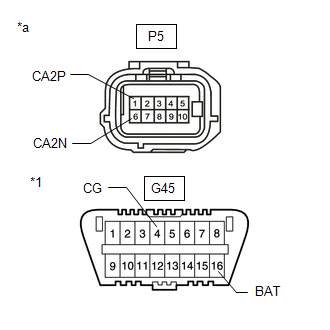 |
|
*1 | DLC3 | |
*a | Front view of wire harness connector
(to Blind Spot Monitor Sensor RH) | | |
| OK |
 | REPLACE BLIND SPOT MONITOR SENSOR RH |
| NG |
 | REPAIR OR REPLACE CAN MAIN WIRE OR CONNECTOR (BLIND SPOT MONITOR SENSOR RH - NO. 26 JUNCTION CONNECTOR) |
| 13. |
CHECK FOR SHORT IN CAN BUS WIRES (BLIND SPOT MONITOR SENSOR LH) |
(a) Reconnect the K68 No. 26 junction connector.
(b) Disconnect the P6 blind spot monitor sensor LH connector.
| (c) Measure the resistance according to the value(s) in the table below.
Standard Resistance: |
Tester Connection | Condition |
Specified Condition | |
P6-1 (CA2P) - G45-4 (CG) |
Cable disconnected from negative (-) battery terminal |
200 Ω or higher | |
P6-6 (CA2N) - G45-4 (CG) |
Cable disconnected from negative (-) battery terminal |
200 Ω or higher | |
P6-1 (CA2P) - G45-16 (BAT) |
Cable disconnected from negative (-) battery terminal |
6 kΩ or higher | |
P6-6 (CA2N) - G45-16 (BAT) |
Cable disconnected from negative (-) battery terminal |
6 kΩ or higher | |
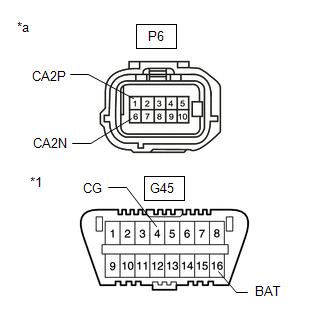 |
|
*1 | DLC3 | |
*a | Front view of wire harness connector
(to Blind Spot Monitor Sensor LH) | | |
| OK |
 | REPLACE BLIND SPOT MONITOR SENSOR LH |
| NG |
 | REPAIR OR REPLACE CAN MAIN WIRE OR CONNECTOR (BLIND SPOT MONITOR SENSOR LH - NO. 26 JUNCTION CONNECTOR) |
Lost Communication with Blind Spot Monitor Master Module (U0233)
DESCRIPTION
This DTC is
stored when the blind spot monitor sensor LH judges that there is a
communication problem with the blind spot monitor sensor RH.
|
DTC No. | Detection Item |
DTC Detection Condition | Trouble Area |
|
U0233 | Lost Communication with Blind Spot Monitor Master Module |
The blind spot monitor sensor (slave) cannot receive signals from the blind spot monitor sensor (master) |
- Blind spot monitor sensor RH
- Blind spot monitor sensor LH
- Wire harness or connector
|
CAUTION / NOTICE / HINT
NOTICE:
When checking for DTCs, make sure that the blind spot monitor system is turned on.
HINT:
- Operating the engine switch, any other switches or a door triggers
related ECU and sensor communication on the CAN. This communication will
cause the resistance value to change.
- Even after DTCs are cleared, if a DTC is stored again after driving the
vehicle for a while, the malfunction may be occurring due to vibration
of the vehicle. In such a case, wiggling the ECUs or wire harness while
performing the inspection below may help determine the cause of the
malfunction.
PROCEDURE
(a) Turn the engine switch off.
(b) Turn the engine switch on (IG).
(c) Clear the DTCs.
Body Electrical > Blind Spot Monitor Slave > Clear DTCs
(d) Check for DTCs.
Body Electrical > Blind Spot Monitor Slave > Trouble Codes
|
Result | Proceed to |
|
DTC U0233 is output | A |
|
No DTCs are output | B |
| B |
 | USE SIMULATION METHOD TO CHECK |
|
A |
 | |
| 2. |
REPLACE BLIND SPOT MONITOR SENSOR RH |
Click here

|
NEXT |
 | |
(a) Check for DTCs.
Body Electrical > Blind Spot Monitor Slave > Trouble Codes
|
Result | Proceed to |
|
DTC U0233 is output | A |
|
No DTCs are output | B |
| A |
 | REPLACE BLIND SPOT MONITOR SENSOR LH |
| B |
 | END (BLIND SPOT MONITOR SENSOR RH WAS DEFECTIVE) |
Software Incompatibility with Body Control Module "B" (U1331)
DESCRIPTION
This DTC is
stored when the destination information of the main body ECU (multiplex
network body ECU) does not match that of the blind spot monitor sensors.
Blind Spot Monitor Master |
DTC No. | Detection Item |
DTC Detection Condition | Trouble Area |
|
U1331 | Software Incompatibility with Body Control Module "B" |
Destination information of the main body ECU and blind spot monitor sensor do not match |
- Main body ECU (multiplex network body ECU)
- Blind spot monitor sensor RH
|
Blind Spot Monitor Slave |
DTC No. | Detection Item |
DTC Detection Condition | Trouble Area |
|
U1331 | Software Incompatibility with Body Control Module "B" |
Destination information of the main body ECU and blind spot monitor sensor do not match |
- Main body ECU (multiplex network body ECU)
- Blind spot monitor sensor LH
|
CAUTION / NOTICE / HINT
NOTICE:
PROCEDURE
|
1. | CONFIRM PART NUMBER (MAIN BODY ECU (MULTIPLEX NETWORK BODY ECU)) |
(a) Check the main body ECU (multiplex network body ECU) part number.
(1) Check if the part number of the main body ECU (multiplex network body ECU) installed on the vehicle is correct.
OK:
The part number is correct.
| NG |
 | REPLACE MAIN BODY ECU (MULTIPLEX NETWORK BODY ECU) |
|
OK |
 | |
(a) Clear the DTCs.
Body Electrical > Blind Spot Monitor Master > Clear DTCs Body Electrical > Blind Spot Monitor Slave > Clear DTCs
(b) Recheck for DTCs and check if the same DTC is output again.
Body Electrical > Blind Spot Monitor Master > Trouble Codes Body
Electrical > Blind Spot Monitor Slave > Trouble Codes
|
Result | Proceed to |
|
No DTCs are output | A |
|
DTC U1331 is output ("Blind Spot Monitor Master") |
B |
| DTC U1331 is output ("Blind Spot Monitor Slave") |
C |
| A |
 | USE SIMULATION METHOD TO CHECK |
| B |
 | REPLACE BLIND SPOT MONITOR SENSOR RH |
| C |
 | REPLACE BLIND SPOT MONITOR SENSOR LH |



























 w/ Seat Memory.
w/ Seat Memory.









 w/ Seat Memory
w/ Seat Memory









 w/ Seat Memory
w/ Seat Memory











 w/ Seat Memory
w/ Seat Memory











 w/ Seat Memory
w/ Seat Memory

























 w/ Seat Memory
w/ Seat Memory










































































































































































































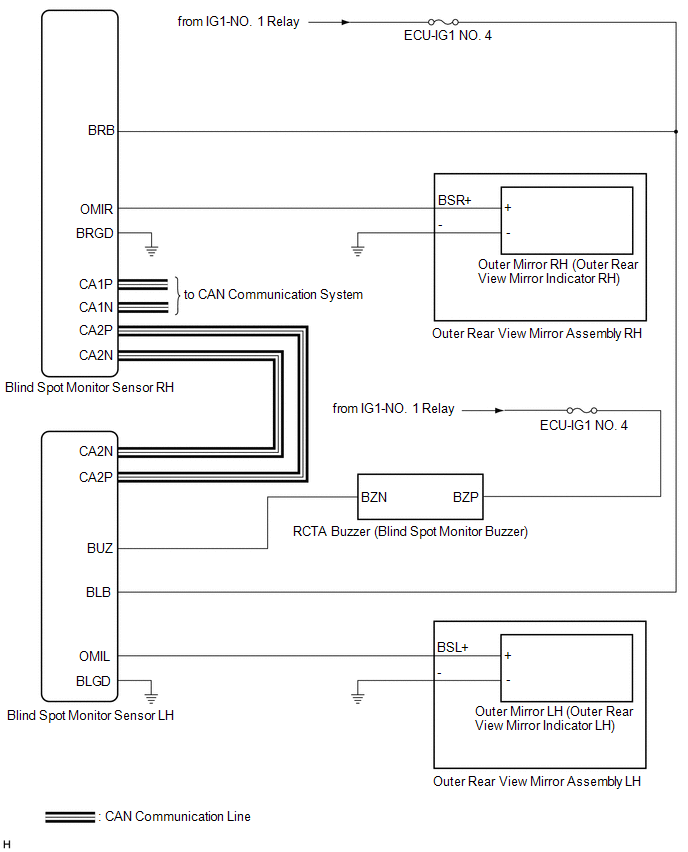 w/ Seat Memory
w/ Seat Memory
